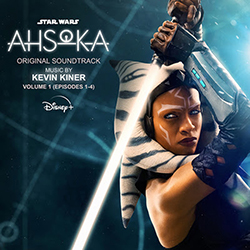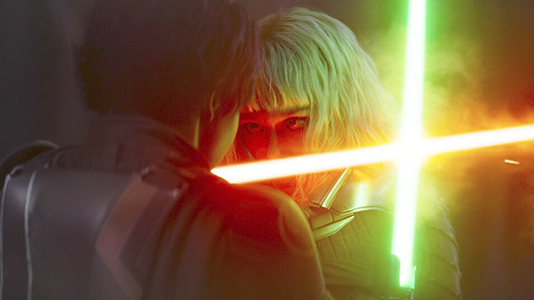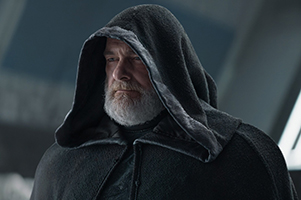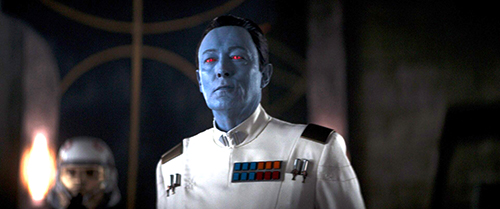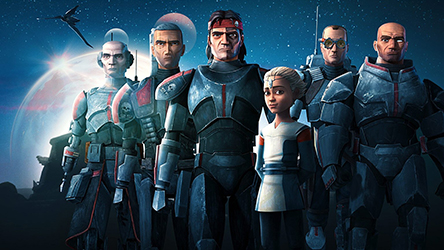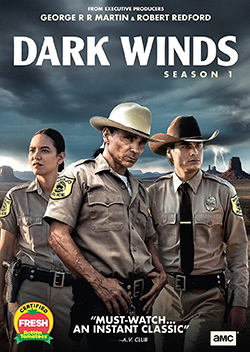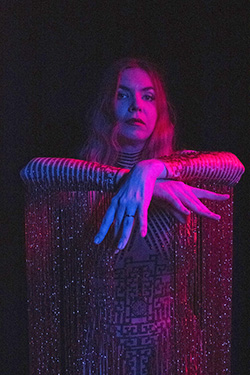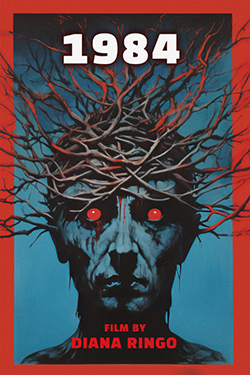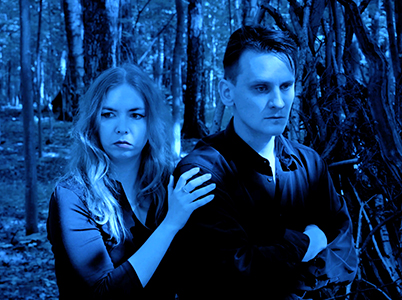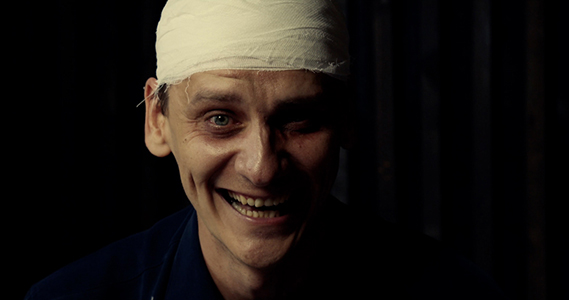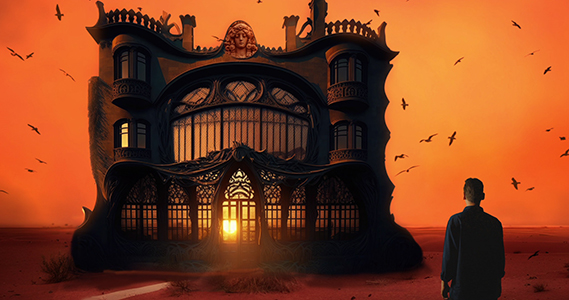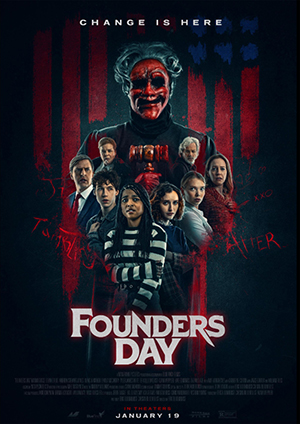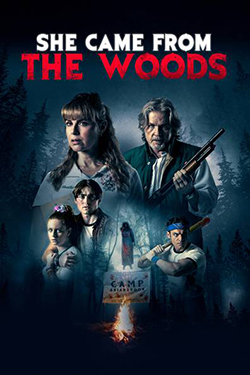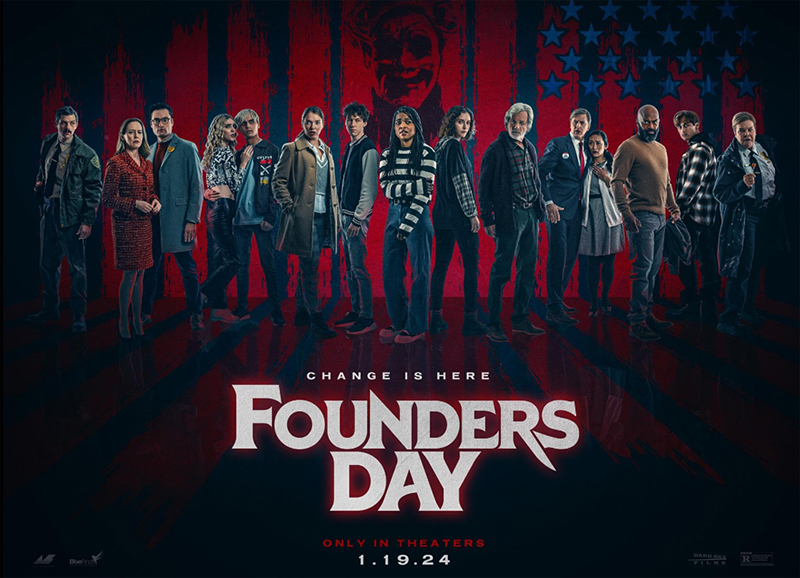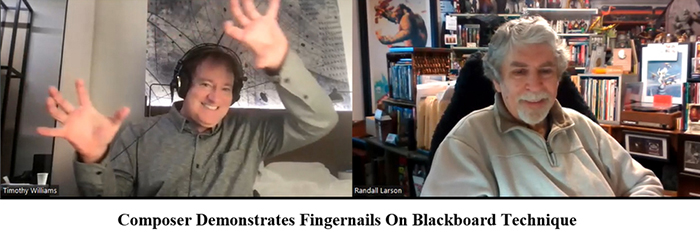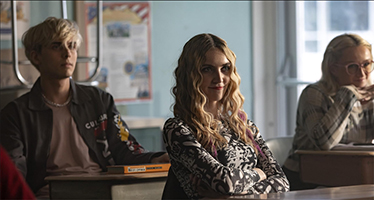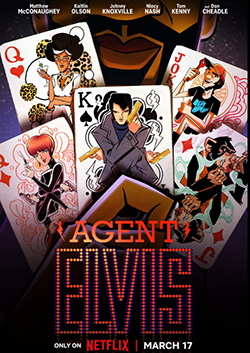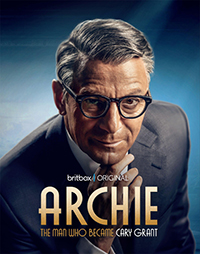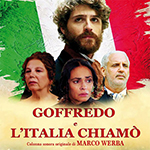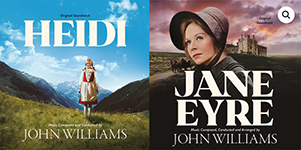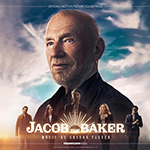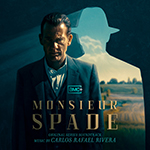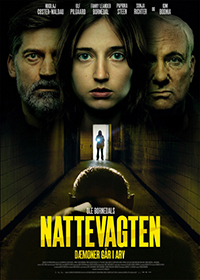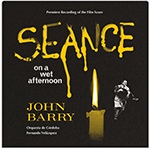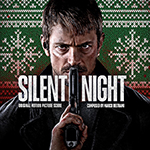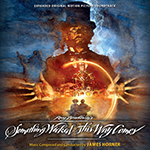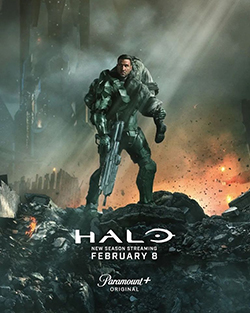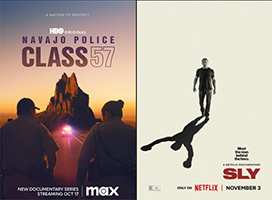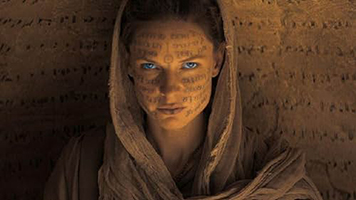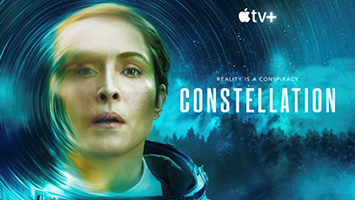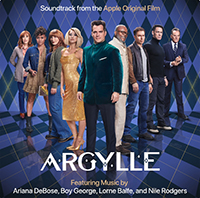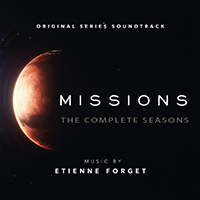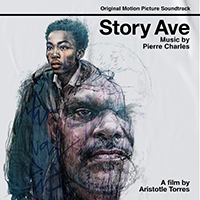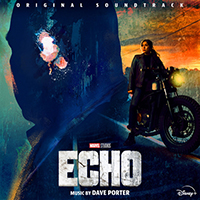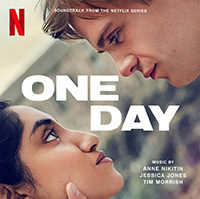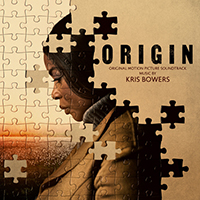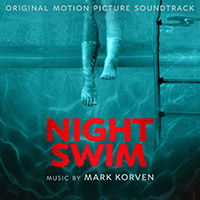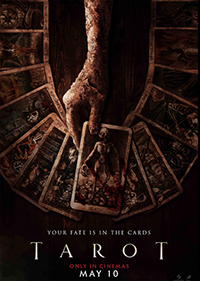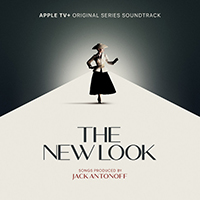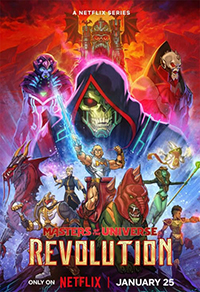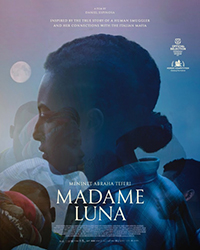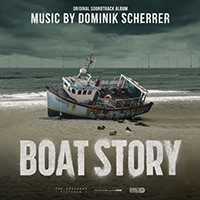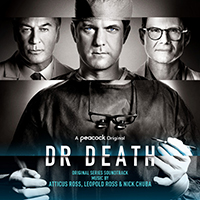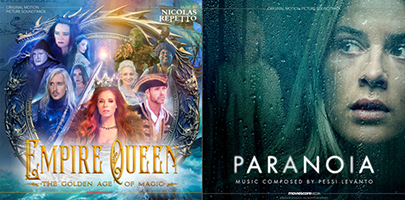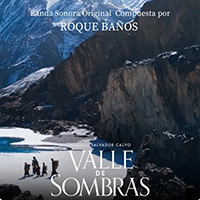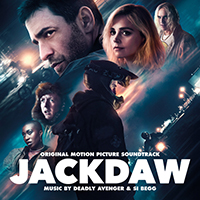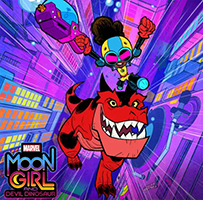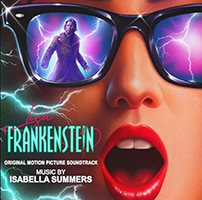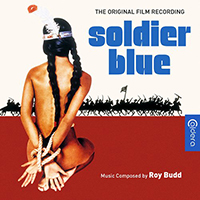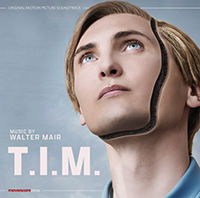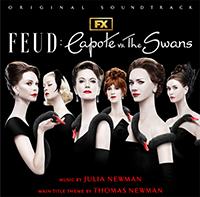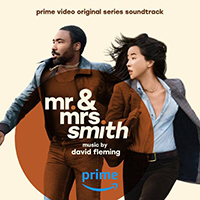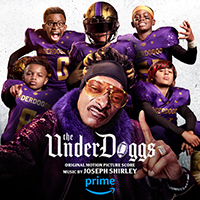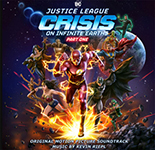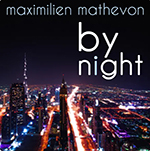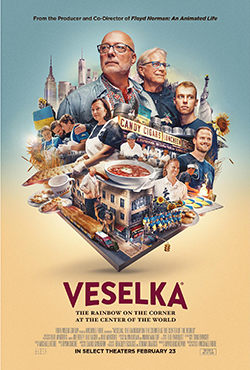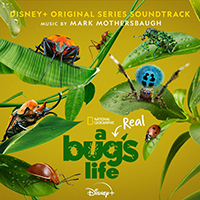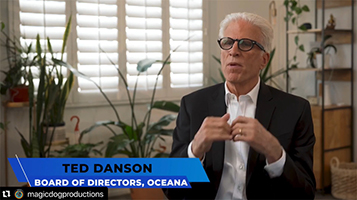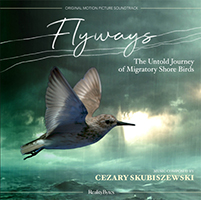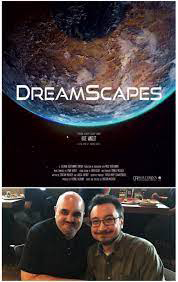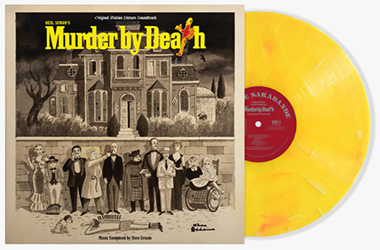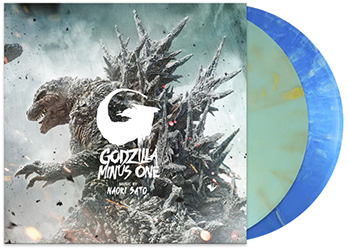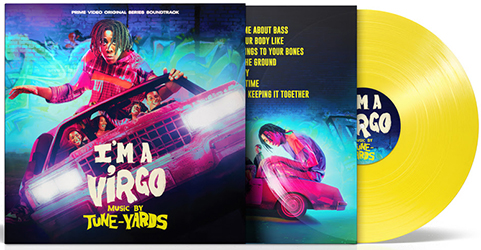Randall Larson (original) (raw)
Soundtrax: Episode 2024-2
January-February, 2024By Randall D. Larson
Feature Interviews:
Kevin Kiner Explores AHSOKA Creator, Composer, and More: Diana Ringo And Her Variant of 1984 Fingernails on the Blackboard: Timothy Williams’ Horror Music for FOUNDER’S DAY
- Soundtrack Reviews
- ARCHIE/Lindsay Wright/Silva Screen
- GOFFREDO E L’ITALIA CHIAMO/Werba/Cinevox
- JACOB THE BAKER/Farber/MSM - digital
- HEIDI/JANE EYRE/Williams/Quartet
- MONSIÉUR SPADE/Rivera/Lakeshore
- NIGHTWATCH DEMONS ARE FOREVER/Torjussen/Wenallt Records
- SÉANCE ON A WET AFTERNOON/Barry/Quartet
- SILENT NIGHT/Beltrami/La-La Land
- SOMETHING WICKED THIS WAY COMES/Horner/Intrada
News:
• Film & TV Music News
• New Soundtrack News
• Non-Film Musical Works by Film Composers
• Documentary Film & Soundtrack News
• Vinyl Soundtracks
Kevin Kiner’s music for the animated series STAR WARS: THE CLONE WARS, STAR WARS: REBELS, and THE BAD BATCH (each now streaming in their entirety Disney+) provided a masterful incarnation of John Williams’ themes and musical identity for these STAR WARS spinoffs, which have maintained their continuity and presence as a continuing part of the STAR WARS oeuvre. Kiner’s three decades as a film composer has resulted in numerous fine works, both on his own and in association with composer Cliff Martinez on the DC superhero series TITANS and THE DOOM PATROL, and much more. In this new interview, I discuss Kiner’s scoring of the live-action AHSOKA series, as well as THE BAD BATCH’s final season and the first two seasons of DARK WINDS, in which two Navajo police officers in the 1970s Southwest that are forced to challenge their own spiritual beliefs when they search for clues in a double murder case.
Listen to the cue “Master and Apprentice” from AHSOKA, via YouTube:
Q: What were your first thoughts about scoring AHSOKA? How did you come up with her theme?
Kevin Kiner: It was an evolution from TALES OF THE JEDI. I think Ahsoka’s themes and Ahsoka herself, as a character, evolved during TALES OF THE JEDI. That show really had a Samurai vibe to it, and I think it was Dave Filoni’s homage to Studio Ghibli and that kind of thing. We came up with sort of a Samurai groove that was the end credits in TALES OF THE JEDI, and that opened the door for a new treatment of Ahsoka’s theme. So, when we got the live-action show, we used that as a foundation and slowed it down, but the genesis was in TALES OF THE JEDI. The melody is not the straight Ahsoka’s theme, at least at the beginning, but it’s based on the Ahsoka theme. It’s like a variation of it.
Listen to the cue “Ahsoka Is Ready” from TALES OF THE JEDI via YouTube:
Q: I like the introductory scene in AHSOKA, “Master and Apprentice,” with your use of piano and the pounding drums, then going into orchestra & rough synth elements as the “Jedi” enter the ship at the opening. Would you describe the sonic aspects of this cue and how it came to be?
Kevin Kiner: I co-write with my children, Sean and Deana Kiner, and Sean came up with that Rachmaninoff kind of vibe. Dave Filoni gravitated to it as soon as he heard that cue – he’s like, “Wow, this is really cool!” We expanded it after he reacted that way because that kind of piano has never been used in STAR WARS. John Williams uses a bit of piano, but not that much, really, and certainly not that way.
Q: In episode 2, there’s some excellent percussion as you introduce Lord Baylan Skoll and Shin Hati as they arrive on Seatos. How did you come to create their music, and how have you used their theme, which runs throughout the first season?
Kevin Kiner: I’ve grown to love Baylan’s theme. As far as the percussion, we use it on a case-by-case basis – just in terms of what the scene is, what we’re feeling, or what Dave is feeling – if the scene needs percussion or it works with the picture well. The picture dictated the percussion elements here. And now, it’s so tragic... I don’t know what we will do with Baylan Skoll’s theme. I’m sure it will live on as Ray’s memory will.
Q: Absolutely. The light saber dual between Ahsoka and Baylan in Episode 4 provides an exciting build-up from tonalities to full orchestral battle music. What can you tell me about creating this music and how you’ve used it in later scenes with these characters?
Kevin Kiner: What was hard to do in AHSOKA was to be eclectic in appropriate and interesting ways. Those were quite a few conditions to deal with at once because it is still STAR WARS, and yet we didn’t want to be derivative of John’s themes and even his sound a lot of the time.
We didn’t want to go where other live-action shows had gone, either. We wanted to be our own thing. So, we produced a playlist of just pieces of music that we liked from all over, from different artists, whether they be recording artists, classical artists, rock artists, indie artists, or whatever. Once we had that playlist, it gave us a tool kit and a palette to guide where we were starting to take things… So, getting back to that scene, when you combine orchestral elements or an orchestral section comes in, you have to realize you’ve started it off with pure percussion or synth; if you’re going to just plug these orchestral elements in, it’s going to be a mess. So the hard part is making it a good piece of music that naturally wants to go to the orchestra but starts with the synth. I’m most proud of that because we pulled that off in a way that doesn’t feel like it’s forced like I have to put a kazoo in here to be different. The music has to feel like it naturally evolves to this place.Q: “Ezra’s Recording” offers an intriguing and gentle sonority for violin, guitar, flute, harp, etc. How did this cue come about?
Kevin Kiner: This is one of the places where Dave was good with us because we’re such huge fans of STAR WARS and the shows we’ve worked on – CLONE WARS and REBELS. Ezra’s theme comes from REBELS, and Sabine’s theme comes from REBELS, and we wanted to use those melodies. What happened was. Initially, we over-used them – and Dave pulled us back and said, “OK, when she sees Ezra, we don’t have to pound in these themes. Let’s just put it in gently and maybe be a little less literal with it, and we can hearken to it.” That took a couple of passes, I think. I don’t believe we ever went more than three passes on a cue because David’s so good at elucidating what the problem is, if there is a problem, and we’re also pretty good at understanding what he’s talking about. We’ve worked for Dave for, like, eighteen years – or I have – and from day one, Dave and I have had a kind of shorthand in our conversations where we don’t need to say a lot of things. We know what the other one is getting at pretty quickly.
Listen to the track “Sabine’s Armor” here, via YouTube:
Q: In Episode 5, you scored the historic Clone Wars battle as we see a young Ahsoka on the battleground with Anakin, a scene I expect you initially composed for the CLONE WARS animated series… How did you manage this sequence in the live-action scene?
Kevin Kiner: It’s probably more ethereal than anything we did in CLONE WARS, but it still hearkens to what we did previously. And I think it’s a reflection of that battle scene because it is some kind of a memory or a dream – I don’t know how to interpret that world between worlds, or whatever it is. So, I think there needed to be that kind of ethereal, washy vibe to it, yet it still had to hearken back to what we’d done in CLONE WARS. Also, that actress [Ariana Greenblatt] is just so fun as young Ashoka. I hope they bring her back in Season 2. That would be awesome!
Q: Your music for episode 6, with choir and percussion, as we introduce Dathomir as she arrives on Peridia and we are introduced to the Dathomiri Nightsisters. I love your cue “Witch Runs;” it’s a deliciously haunting and worrisome musical characterization of these witches – how did this music come about, and what were its sonic elements?
Kevin Kiner: We go back to CLONE WARS, where they were the Nightsisters, but, really, that’s not the genesis of that cue. When we first saw these witches, we started talking – are these going to be related to the Nightsisters, musically or anything? I think more philosophically and in terms of tone; it has a similarity, but melodically and theme-wise, it’s not derived from the Nightsisters. That’s just one of those things – I don’t know where that came from! You start kind of jamming, and things take you a certain way.
Q: In the same episode, you provide a gargantuan and eerie sonority as Thrawn’s immense star destroyer arrives above the Peridian temple. Your music is deliciously wicked and penetrating.
Kevin Kiner: When Thrawn arrives, we were very excited about that. Initially, it was too busy, and Dave had to pull in the reins and say, less is more. The scene itself is just insanely great. This was not a place to go “dadada-dun-de-da-dun-de-daaa (Imperial March)!” It also wasn’t a place to go flat out with the organ theme that we had developed for Thrawn. There were a couple of ideas that we discarded, even before we played it for Dave where we tried to go flat-out with the organ and full-on Bach, which was just too much. So, we ended up trying to capture the intimidating presence that Thrawn innately exudes by making the music feel both enormous and effortless. We stretched his theme out so it plays much slower and utilized a distorted organ to add an extra edge to the feeling of his entrance.
Listen to the track, “Grand Admiral Thrawn,” via YouTube:
Q: Episode 8’s battle music between Ahsoka and Morgan Elsbeth, midway through the episode, matches the battle between Sabine and Shin with some unusual trumpet material. Would you describe these sequences and some of the most unusual instruments you’ve used in the score’s elements?
Kevin Kiner: In the track “What Was Required” on AHSOKA Vol.2, you can hear many unusual instruments we use for our duels. Many of them are small flutes I’ve picked up on my travels. One of them that features prominently is a flute I got at a souvenir stand in the middle of nowhere in Hawaii for $8. It’s not always about how expensive or master-built an instrument is; sometimes, it is just about how you can use it in an unusual way. On top of the flutes and the taiko drums and dhols we have, we love to put audio effects on interesting instruments like the Japanese hichiriki (a double-reeded wind instrument – which I think is the trumpet-like sound you hear). We find those treatments will make a piece of music more unique, and we also have so much fun experimenting with new sounds. It’s a very mad scientist approach sometimes.
Q: You’ve probably had this question asked in all the interviews that you’ve done for AHSOKA, dealing with John Williams’ music, but what can you tell me, or describe those moments, when you add a bit of his music to a scene and now we have the Williams’ sonic dimension on top of what you are doing in the music?
Kevin Kiner: We always describe it as a spice that we use extremely sparingly because it’s the most potent spice you can have anywhere. His stuff is so good and iconic and gives you such a feeling of STAR WARS, but it’s been used often. We have to be careful. We initially had the Force Theme in a different scene – I think it was in episode seven or eight. But it was decided to put it in a different place, and it shows up now with Ezra’s jumping across that chasm. Dave didn’t say this, but it wound up being that we could only use the Force Theme one time. If we want to do this right, we can’t use it two or three times; we can only use it once. But that makes it unique. That wasn’t like a rule we came up with, but it just naturally happened that way, and I think it’s really for the better because John’s stuff is so strong. I mean, John owns STAR WARS. He started STAR WARS, and he started me wanting to sound that way back in the ‘70s. He’s the genesis of everything. But now we’re taking things in a different direction because there’s a lot of STAR WARS material out there. When I first mentioned to Dave Filoni after I first screened AHSOKA, I think we screened the first two episodes with him, and we didn’t spot them then; we just watched them. After I watched it with him, I said, “Dave, you’ve made STAR WARS!” That seems like an obvious comment, but I meant that he’s gone back to the OG, the feeling you had when you first saw A NEW HOPE, and EMPIRE STRIKES BACK. I think he captured that – while not using the same stories or the same devices – but he knows how to capture the spirit of STAR WARS, and I think that was the trick for us, in composing, too – to capture the sound and the feeling of the music of STAR WARS without being imitative, and without just regurgitating stuff that’s already been done.
Listen to “Ahsoka - End Credits (From “Ahsoka”/Visualizer Video)” via DisneyMusicVEVO on YouTube:
Q: Tell me about the demo track you’ve got on the soundtrack album, “Igyah Kah.” How did this wildly raucous cue come about?
Kevin Kiner: We just did an interview with ENTERTAINMENT TONIGHT, and Dave was on, and he said, “I bet I can tell you which cue was the hardest of all the cues you wrote!” We did five hours of music in about two and a half months or three months, which is insane! All of it went to the orchestra, except “Igyah Kah” – there’s no orchestra on that. But Dave wanted to introduce Sabine with something really rocking. And so, we thought, let’s punk it up. I think the natural feeling of that piece of music is like a record. It’s not like score. Now, it does do score-y things in that it goes down when she slides underneath the other ship and stuff like that, but mostly, it’s a rock and roll tune. That took quite a few passes. On the demo track, we thought putting some Indian percussion would be cool, and I think it is, but the one that finally made it into the picture was the one with just a regular bangin’ punk drum set. In the final analysis, if you’re going to be punk, have a drummer! Don’t put in Indian percussion or some ethnic percussion! But that’s why we included the demo version, because it was a nice variation; we liked having that on the soundtrack because that’s how Igyah Kah started.
Q: What can you tell me about the season finale of THE BAD BATCH, which premieres February 21st?
Kevin Kiner: This is the final season as was planned from the beginning. From day one, it was going to be a three-season show. What I can tell you is, we recorded it in Vienna. I conducted it, and I had a fantastic time doing that. I loved the ending, and the last few cues will be very special. I think Omega’s theme, which Sean mostly wrote, was one of the cooler themes we’ve come up with, and it plays prominently in the finale. I can tell you that!
Watch the trailer for THE BAD BATCH Season 3 via YouTube:
Q: I wanted to ask about scoring DARK WINDS. I’m a big fan of DARK WINDS and have been eagerly watching both seasons (so far). What can you tell me about scoring this psychological/Western noir crime drama and keeping it within the boundaries of Navajo culture and environment?
Kevin Kiner: One thing on DARK WINDS was we were quite conscious of cultural appropriation, so we stayed away from doing anything like that. The sound of DARK WINDS needs to evoke the desert and atmosphere of the West. It’s funny: Robert Redford is one of the executive producers, and he came down to set and sent us all a nice note, which was so cool! So we can say that we worked with Robert Redford once in your life! I think Robert Redford loved the books [based on the Leaphorn & Chee novel series by Tony Hillerman]; he’s definitely into Americana and the West. I use a lot of guitar-viol, which is a fretted cello, a cross between a guitar and a cello. I’m pleased with how Season 2 turned out. Musically, there’s no similarity between AHSOKA and DARK WINDS, of course, except for the strategy of using unusual instruments and making unusual musical choices.
A lot of DARK WINDS is about found instruments, found sounds, and playing instruments in ways they are not meant to be played, like bowing Middle Eastern instruments. There’s a Turkish instrument called the Tambur, which is a big, long-necked instrument that’s usually strummed in the Middle East, but we bow it using a violin or a cello bow, and it gives a distinctive sound that still hearkens to the West. We use percussion, but we play it all ourselves. Sometimes we’re just banging on guitars, or I have a guitarrón, the Mexican bass they use in mariachi bands, and sometimes I’ll play that, and it becomes my bass drum. There are just a lot of unusual found sounds — and even finger-picked guitars, which are in the opening credits. A duduk, a Middle Eastern kind of oboe, plays the melody along with a solo violin. There are a lot of soloistic cellos or guitar viol. And, again, we keep experimenting. I will turn the bow around and hit the cello strings or the guitar viol. It’s called col legno when you’re doing it on a cello or violin, and it turns them into rhythm instruments. When you don’t know what the instrument is, you’re just hearing it; there’s just an organic woody-ness that fits the West. So, we approach it that way rather than doing any Navajo music. If there will be Navajo music, we’ll let the music supervisor bring something in, like a record of actual Navajo people playing. And they don’t call themselves Navajo, by the way – they use a different term, Dine’, which means “The People,” and we use that term in the show. We’re starting on Season 3 in a few months, and I’m very excited to do that.
Listen to the opening theme from DARK WINDS via YouTube:
Special thanks to Jason Fujita for arranging this interview for me and to Kevin Kiner for his warm recollections on scoring AHSOKA and a few other recent scores.
__________________________________________________________________________________________
Diana Ringo is a film director, pianist, composer, and more from Finland. She is known for her dystopia feature films Quarantine (2021) and 1984 (2023), a Finnish-Russian black comedy-drama film. Ringo’s eclectic musical style draws on various influences and genres, spanning classical, electronica, ambient, and avant-garde music.
Her film is based upon George Orwell’s 1949 novel of the same name and Yevgeny Zamyatin’s 1920–1921 novel We. In addition to directing the film, Ringo wrote, produced, and created the film’s score, serving as a cameraman, editor, and performer in one of the primary roles. “Orwell’s novel continues to resonate with readers across generations all over the world as his story of the perils of totalitarianism and the choices we make regarding the safeguarding of our freedoms remains as pressing today as when he originally penned the novel,” Ringo told an interviewer from Indieboulevard.com. “I believe that the film will leave a lasting impact, much like the novel it is based on, and encourage viewers to reevaluate the world around them.”
Diana’s score for the film is a compelling mix of ambiance, abstraction, and archaic and futuristic reflective constructs. The scope of the music is tentative and frightening, enhancing the dystopian backgrounds of the cityscapes, the cadaverous sonic shapes embracing its massive congregations of humanity, and the tentative escapes some make into forbidden forested grandeurs, and elegantly ruminant cyclopean metropolises where only the conscripted may attend, and where the substances of totalitarianism hold many more against their will. The music makes a fascinating pattern, unhappily dark but for a few hopeful found amidst a forbidden forest or an unexpectedly hesitant interlude with an engaging partner.
Watch the “1984” trailer:
Q: What were your influences on making this film – and how would you describe your take on its meaning, with its relevance to both “1984” and “We?” What do you feel is it’s “genre”?
Diana Ringo: “_1984_” is not just a book; it is a mirror reflecting our past, present, and future. George Orwell and Evgeniy Zamyatin investigate similar topics, such as unlimited power, enslavement of people, dehumanization, and protest against totalitarian power. Also, the theme of betrayal is essential in both works.
As I revisited Orwell’s “1984,” I found myself contemplating the profound influences that shaped George Orwell’s perspective. For example, it is well-known that “_We_” was the original inspiration behind “_1984.” Also, I see a lot of parallels between “_1984_” and the classic sci-fi film “_Metropolis.” Another source of inspiration for me was Fyodor Dostoevsky and his book “_Notes from Underground_” – it had a lot of concepts that were later adapted by Evgeniy Zamyatin and George Orwell.
Ridley Scott’s “_Blade Runner_” and George Lucas’ “_THX-1138_” stand out among the science fiction films that significantly impacted me. These films immerse the viewer into distinct worlds and are truly innovative works. I also adore the Westerns directed by Sergio Leone; I am inspired by the synthesis of music and his original directorial approach.
I see my film as a blend of science fiction, drama, and dark satire. Elements of black comedy and absurdism were important for me, as “_1984_” and “We” had a lot of humorous moments, while the previous film adaptations did not reflect these subtleties. We observe history repeating itself as a farce, emphasizing the importance of viewing certain situations through the lens of black comedy. Zamyatin’s book describes how the society tries to destroy people’s fantasy in order to enslave them completely. Orwell despised propaganda, and though his book inadvertently became a tool of Cold War propaganda, it’s crucial to deeply ponder and reconsider Orwell’s exact message. Everything Orwell wrote keeps resurfacing and resonating with our reality. Also, it was important for me to add additional elements to the story regarding new technological advancements that can be used to enslave humanity.
Q: How were your digital visual effects created, and how did you use these images to contrast and supplement the film’s texture and environments?
Diana Ringo: I approach each frame as a work of art, closely examining elements such as light, set design, composition, and color. Initially, it was crucial to ensure that all the fundamental elements were perfected, creating an impressive bare-bones version of the picture. Only then did the process of adding the visual effects commence, serving as the finishing touch to breathe life into the fantastical world of the futuristic city.
I envisioned the film to exhibit stark contrasts between the futuristic yet bleak dystopian reality juxtaposed with the vivid, colorful dreamscapes of the protagonist. In this world, conformity is enforced with uniform attire, and love and fantasy are forbidden, with severe consequences for non-conformity. Conversely, the protagonist’s subconscious is a realm of vibrant and captivating imagery. Many digital matte paintings were created for compositing work. The software used for the visual effects included After Effects and Blender. It involved a lot of experimenting and constant adjustments to get the effects right.
Q: How would you describe your score for the film – its musical designs and textures within the film? How did you achieve some of its unique sonic elements?
Diana Ringo: In conceptualizing the film score for “1984,” I aimed to craft a musical tone poem by evoking the intense emotions of the narrative through the music so that the score can also be enjoyed separately and still provoke a deep emotional response. The last thing I want to do is compose generic-sounding music; for me, every track must be unique. I composed the soundtrack with Logic Pro X, using various plugins, including multiple synth plugins by Native Instruments and Serum by Xfer Records. For me, synthesizers offer a practically unlimited canvas for my musical ideas, as I always have an entire orchestra at my fingertips. Layering and adjusting the instruments is always exciting, as even a slight adjustment can completely change the character and mood of the piece. Working on the orchestration is like adding color to a drawing; I listen to the sounds repeatedly and let my imagination go wild. When I am writing music, I never have any preset plan; I always start with a blank project and just try out different musical ideas and see if there’s something that excites me, whether it’s a specific melody, a chord, a strange synth sound, texture or anything else. Something I greatly enjoy about film scores is that there are no rules.
Q: How did you configure the music to complement your imaging effects? Which musical designs were you using to create the film’s sonic environments?
Diana Ringo: I worked a lot on the soundtrack so that it would have the variety to depict the spiritual transformation the lead character experiences. Whether he is experiencing fantasy and romantic feelings for the first time, the mysterious and futuristic atmosphere of the world, or his doubts, fears, and desires – I wanted every moment to have a distinct and unique atmosphere so that you could immediately tell what the characters are feeling just by listening to the film score.
Q: Would you describe your visual and sonic abstraction to convey the film, and how did these elements, along with dialogue, set design, and characterizations, develop uniquely to create the kind of film story and representation you sought?
Diana Ringo: I started composing the score when I had a very rough film cut. I needed to be inspired by the actors’ performances and personalities. While editing the film, I was constantly composing the film score up until the final cut of the movie since it was essential to get the music right. I enjoy the fact that I both compose the music and do the film editing since it gives me more freedom to implement the music exactly the way I see it and that I know that the music will genuinely fit every frame of the film. I treat the music like a distinct character who is vital for the success of the film.
Q: What have you wanted your audiences to take away from your film and its creative elements?
Diana Ringo: Ultimately, I want the audience to reflect on the fragility of freedom and the consequences of unchecked power. The film is a warning, a visceral experience that encourages viewers to question authority and cherish the liberties we often take for granted. I hope it sparks conversations about the timeless relevance of these dystopian tales and the imperative of safeguarding our individuality in the face of oppressive regimes.
It’s crucial to remember that no technological progress can substitute the essence of humanity – creative imagination, independent thought, and freedom are the quintessential qualities that define us.
Many thanks to Diana Ringo for discussing the music and creative structure of her remarkable film. - rdl
For more information on Diane Ringo, see her website here.
____________________________________________________________________________________________
It’s FOUNDER’S DAY in the small town of Fairwood, where the community is shaken by a series of ominous killings in the days leading up to a heated mayoral election. Directed by Erik Bloomquist, the film stars Jayce Bartok, Catherine Curtin, Amy Hargreaves, William Russ, Emilia McCarthy, Naomi Grace, Olivia Nikkanen, and Devin Druid.
The Composer: Timothy Williams, a multi-award winning composer best known for his work on BRIGHTBURN, GET OUT, GUARDIANS OF THE GALAXY VOL. 1 and VOL. 2, DEADPOOL 2, HOBBS AND SHAW, BUTTERFLY CIRCUS, scores the film. Williams, a National Film and Television School graduate, has won numerous awards and holds over 110 feature film credits. Besides the movies above, for which he orchestrated and wrote additional music, Williams also conducted the scores for CHRISTOPHER ROBIN, HIDDEN FIGURES, ANNABELLE CREATION, IT, and IT 2. His and Kieran Kiely’s score for FINDING YOU and HAVE YOU HEARD ABOUT GREG?, co-scored with Chad Cannon and Jesse Carmichael, have been released by MovieScore Media, as well as the previous Bloomquist film SHE CAME FROM THE WOODS and the uplifting indie drama GRINGA. He’s also maintained an ongoing collaborative relationship with composer Tyler Bates on films such as WATCHMAN, GUARDIANS OF THE GALAXY 1-2, PEARL, AGENT ELVIS, and others.
The Score: “Working with the Bloomquist brothers is always an incredible journey into interesting worlds. In FOUNDERS DAY, we enter a town where political rivalries and tensions are bubbling under the surface. Amongst this, an unknown violent serial killer begins a killing spree and sets the town even more on edge. One of the things that struck me about the film is the incredibly violent and visceral slashing kills that led me to want to create a hybrid electronic, guitar, and orchestral-driven score that is equally as visceral and violent. I hope you enjoy it as much as I did writing it.” – Timothy WilliamsWatch the FOUNDER’S DAY trailer:
Q: You’ve worked with director Erik Bloomquist on three occasions this far – SHE CAME FROM THE WOODS (2022), INTERMEDIUM (2023), and the new FOUNDER’S DAY. How did you connect with him?
SHE CAME FROM THE WOODS: A group of counselors unleashes a decades-old evil, long-buried secrets and bloody mayhem on the last night of summer camp in 1987.
INTERMEDIUM: An obsessive-compulsive teenager searches for a way to rid her home of the ghost that haunts it, but their unexpected connection makes it hard to let go.
FOUNDER’S DAY: A small town is shaken by a series of ominous killings in the days
leading up to a heated mayoral election.
Timothy Williams: I connected with Eric through my agent, Dan North, at Kraft-Engel, and he said, ‘A hot new director is coming up; you should meet with him.” I met with Eric and his brother, Carson, and was impressed by their work. They have this excellent throwback quality to what they do, like an aesthetic for 80s and 90s horror films. SHE CAME FROM THE WOODS was a horror film set in that sort of camping trope – kids in cabins in the woods, and this woman arises. INTERMEDIUM is an incredible project. I’m not sure what the distribution plans are, but it won some awards here in New York, including Best Score. In INTERMEDIUM, I co-scored with Summer Joy Davis, an incredible singer. It’s a horror rom-com, which, funnily enough, I’ve just finished YOUR MONSTER, which is also another rom-com horror, which just premiered at Sundance for Caroline Lindy. It seems an exciting new genre. In the case of INTERMEDIUM, a girl falls in love with a ghost in the house. He’s a rather handsome young guy who died, and she has severe OCD. At first, she’s like, “What are you doing in my house, in my room?” and he’s got this suave attitude. They eventually fall in love, and the story is about her discovering how he became a ghost and helping him move on.
FOUNDER’S DAY is set in a backdrop of this small town going through a political election. The incumbent and a new mayor are running, and behind all of this, you have a serial killer, who we call Founder. He wears this wig and has this hammer with a huge spike in it. When I first went through the film with Erik, I said, “I don’t think I’ve seen anything quite this visceral and terrifying. It’s very well shot with some incredible angles, and so, for that one, it needed quite an aggressive score. So we had a lot of fun with that.
Q: The horror genre is clearly in a boom these days and has been for a long time. When you first come on board a new horror film, such as FOUNDER’S DAY, how have you prepared the kinds of scares the film needs while creating the gradual tension and outright horrific textures that haven’t been heard before in horror?
Timothy Williams: That’s a good question! I think the process is the same for almost every film, which is trying to find the film’s tone. What is the musical language of the movie? For PEARL, for example, [director] Ty West was very clear about wanting an Alfred Hitchcock-styled score reminiscent of Bernard Herrmann, and that was the musical language. But the principle was the same – to tell the story through music, to create those moments that are terrifying and draw you in, and also to lay an emotional foundation for the score. Having some emotion in places is essential because you want to connect with the characters. The more you connect with characters, the more frightened you will be when they’re in jeopardy.
“Part of the fun of horror films [is] that you can take the audience on a journey and have them sitting on the edge of their seats.”
The process is similar to most films. I sit down with the director; we watch the movie, and we talk about where there should be music, where there should be silence – because that has its impact – and especially the transition from either silence to something very loud or just creeping in with some tone and then building that tension to the moment where it shatters. I think that’s where the word “suspense” comes from because the whole point of horror is: something’s coming, something’s coming, oh-my-goodness, what is it?! You know! And I think that’s part of the fun of horror films, that you can take the audience on a journey and have them sitting on the edge of their seats. We map that all out and break that down into cues, which I then create and get notes. Hopefully, I will get to a place where everyone’s happy with them!
Q: With FOUNDERS DAY, what was your start, working with Erik, to deduce the kind of musical patterns that this film needed?
Timothy Williams: Visually, this film is very striking and visceral. The opening scene has these two women on a bridge, and this truck comes up with its headlights glaring, and so, immediately, it’s terrifying because you can’t see with the headlights there. And, of course, they’re immediately thinking this is some joke. They’re like, “What are you doing?” And the person in the truck isn’t responding. So, just as they’re turning to ignore the guy, the Founder suddenly appears with this creepy outfit and carrying a heavy gavel, and you get this vicious, brutal attack. That set the tone for the whole movie. I wanted something electronic but also orchestral, what I would call a hybrid – heavy guitars and a lot of percussion. It was just striking in terms of the music; one of the sounds I used was fingernails on a chalkboard! You can really hear it in the soundtrack! I found some great samples of fingernails on the chalkboard, which give it a sense of just terror and violence – to find some mixtures, pulses, energy, and orchestral effects to capture that action.
Q: You’ve mentioned in your label notes the hybrid electronic guitar and orchestral techniques that drive this score. How did that mix come to mind, and how have you used it in this film?
Timothy Williams: Mainly, for me, the electric guitar was perfect just to, again, give a little bit of a nod to the ’90s and give some weight and heaviness to the villain of the piece. A lot of the metallic hits and things like that are the same thing: it’s using some of these fingernail scrapes into these metal hits that can give some excellent aggression. Then, I had a few things where I was also using voice. I had an incredibly talented singer over, and we were doing all kinds of techniques – holding notes, wavering notes, doing “_chhahaaasss_” into the microphone, and just building these textures that were terrifying and built to these moments. It was a lot of fun, shaping the drama through music. I think I’m up to a hundred and 20 scores now, or something like that – but I don’t think I’ve written a score as violent and visceral as this one! I believe Erik has a knack for that type of suspenseful work and those vicious attacks. I haven’t seen anything like that before, visually and still very artistic with the angles he picks. It was definitely a fun film to score!
Q: Your score ranges from suspenseful and scary interludes while providing gentler tunes such as “Adam’s Story” and the keyboard and percussion tonality of “Puzzlebox.”
Timothy Williams: One of the nice things about film – any of these horror films, actually – is when you get a chance to get to know the characters, get to know their backstory, get to connect to them emotionally, as people, and then, you learn to care about them more, and you won’t want them to come to harm. So, this film offered some great opportunities to provide some emotional connections. Relationships are going between people who care about and are attracted to each other, and some romances blossom during this. It’s what I tend to call “life normal” in a horror film. What is ordinary life like before the monsters come? I think a lot of those beats give you a little breath from the action, from the scare, and provide that opportunity to do something beautiful and emotional and draw you into the characters.
Q: In horror, musical themes tend to provide some familiar orchestral territory for viewers. At the same time, the more horrific moments often avoid recurring elements and offer new types of scary material – just for that reason. What’s your technique for crafting unique terrors in your scores, such as this one?
Timothy Williams: In this particular case, it really was fingernails on the chalkboard, which is a hugely cool effect. I also leaned quite a bit into an incredible synth library from u-he; they have this synth engine called Zebra, which has quite a lot of exciting libraries created for it. I know it’s a synthesizer that Hans uses all the time, all over – Batman and all these different films that he’s done, but it’s an incredible synth engine. I had an assistant who spent two or three weeks combing through all these other libraries, collating a group of sounds that I thought would be good – some low hisses and growllls, and things like that. I had some very high sounds as well. There was one patch called Vogue, which was this very high, strident thing that worked very well with some of the images before the strikes, some terrifying high things. We spent quite a bit of time finding some interesting sounds and then combining those with big guitar hits, drum hits, and percussion hits to give some scope to the Founder.
Q: The fun part of horror movies is often the relief an audience has when the horror is finally gone. Your cue, “Founders Day: Outro,” offers a pleasing mix of electronics and percussion, while a female vocalise provides a respite to the horrors that have gone before. When mapping a score like this one, how do you unpack the horrific elements and provide the respite of survival at the end of the story?
Timothy Williams: This is where, again, you can lean on themes, which can be very useful. For FOUNDERS DAY, the whole intro and opening set up this East Coast town. I was fortunate to work with Tori Lextler, an incredible vocalist and a great composer in her own right. She came over, and we crafted this sort of town theme that was very mysterious. It’s a bit _Twin Peaks_-ish – retro in that way. It is a little sleepy East Coast town where not a lot goes on, and we wanted to craft that as a theme. But, by the end, you’ve been through this very traumatic adventure, so we wanted to have the moment where the whole narrative is explained, and you start to see the mystery and the twists and turns that have taken place all become very clear. That was the point at the very end, her understanding of what was behind it all, coming to the end of the mystery.
Q: You’ve worked a lot with Tyler Bates on several projects across the years, and I want to ask you about one that I particularly enjoyed watching: AGENT ELVIS. What can you tell me about getting into that score and the mix of vibes that it needed?
Timothy Williams: Oh, thank you. AGENT ELVIS was such a fun project! Weirdly, it was done concurrently with PEARL, so we were working on the PEARL score, and at the same time, we were doing AGENT ELVIS, which is, for those of you who don’t know, please go and check it out on Netflix. (interview continues below)
Watch the AGENT ELVIS trailer via YouTube:
Timothy Williams: It’s an animated series by Sony Animation, the same time people who did the animated Spider-Man movies, and it has this fascinating premise of, what if Elvis were a secret agent on the side? It was done with some of the top comic actors of our day – the lead is Matthew McConaughey, who does a wonderful turn as Elvis, and then it’s SATURDAY NIGHT LIFE alums and THE OFFICE alumni. Fred Armisen, for example, plays Charles Manson in the first episode, where Elvis has to do and battle with him. It’s very absurd, very funny, and very irreverent. The actor who plays SpongeBob SquarePants, Tom Kenny, also voices Scatter, this very obscene monkey friend of Elvis’s; it’s his pet monkey who likes cocaine and all the rest of it. He’s a very wild character. So, the score for that needed to feel very consistent. Of course, one of our references is James Bond – we’re slightly in James Bond mode, so there are the John Barry-esque-type colors to the score. But it’s also a rock-and-roll score, so it needed to feel like Elvis but as a spy.
It also allowed us to do a lot of really fun, retro-’60s type material – and this is something that is so much in Tyler’s wheelhouse, that wonderful retro guitar vibe. We had Gil Sharone, one of the best drummers, on drums. Tyler does an incredible bass, we had strings, and we did a lot of live brass on it, too, because we had one episode in Vegas, of course; there’s an episode where we go to the White House where he meets Nixon, so it’s all these iconic Elvis moments. The final episode is almost like MOONRAKER or a 2001 reference where he’s in a spaceship going out to space, and he’s trying to take down the mega-villain who’s planning world domination. It’s a very, very funny series. Still, it allowed us to lean into that period of really unique ’60s style, both the druggy-type music, the female vocals, and some Rolling Stones-type vibes to evoke that era. There’s a Vietnam episode. It’s all the iconic stuff from that period done in an incredibly irreverent way! I couldn’t believe it was Sony Animation – it’s so funny and impertinent. I think people who are fans of the ARCHER-type animated, adult things would enjoy it! As long as you go into it – a lot of people went into it with a sense of it’s going to be Elvis as we knew him, and it’s not that; it’s much more of this mash-up of a fictional Elvis who is a secret agent, and all the icons of the ’60s. We had a lot of fun doing it, and I thought the score turned out well. It’s very different from anything either of us had ever done.
Q: Is there anything else coming up that you can talk about?
Timothy Williams: Yeah. I have a couple of films coming down the pipeline. I did a Lionsgate film called BAGMAN. It stars Sam Claflin, who just got nominated for a Golden Globe. It’s directed by Colm McCarthy, best known for PEAKY BLINDERS, and it’s a horror story based on this creature, Bagman. I’m not sure what the release date is for that. Then I just finished a fantastic 1960-set Peruvian film called MISTURA, by award-winning director Ricardo de Montreuil, and that one is a beautiful drama about a woman whose husband leaves her. She finds herself destitute, so she opens this restaurant. The movie delves into the emergence of fusion cuisine, which we know best as Nobu. It’s based on a true story about a mother in the 1960s who started this fusion cuisine and how it became trendy. It’s just a beautiful drama. And then I’m working on a film called SOMEWHERE IN DREAMLAND, a horror film by Ley Line Entertainment, who did EVERYTHING EVERYWHERE ALL AT ONCE. The director of that is an incredibly well-known music video director, Colin Tilley. The movie is his first foray into feature films; it’s set in Florida, and it’s a beautifully shot film about a creature called the Sandman who comes in your dreams, but there’s sort of a karmic element to it: you get your name written on the tree if you’ve done something wrong - this creature comes at night and will take your eyes out, so it’s pretty terrifying! So those are the films coming up pretty soon, and of course, YOUR MONSTER, which just opened at Sundance, is a beautifully shot rom-com horror film.
Listen to Tyler Bates & Tim Williams’ Main Theme from AGENT ELVIS via YouTube:
Special thanks to Tim Williams for talking to me about FOUNDER’S DAY and AGENT ELVIS! Read more about the composer at his website.
The soundtrack album for FOUNDER’S DAY has been released digitally by MovieScore Media, with CD On Demand forthcoming.
____________________________________________________________________________________________
Overviews: Soundtrack Reviews:
ARCHIE/Lindsay Wright/Silva Screen – Digital
Lindsay Wright’s score for Archie, ITV’s serialized biopic of Cary Grant, depicting the man initially named Archibald Leach (hence the film’s title), born into poverty in Bristol in 1904, before he became Hollywood’s Cary Grant, which sets a uniquely sad profile of the Hollywood star, taking the viewer through his tumultuous life and focusing on later years. Directed by Bafta-winning Paul Andrew Williams (MURDERED FOR BEING DIFFERENT), the film stars Jason Isaacs as Grant and Laura Aikman as Cannon. British Composer Lindsay Wright (HBO/BBC’s THE MYSTERY OF D.B. COOPER, ITV’s drama SERIES THE WALK-IN, BBC 1’s BLACK OPS, and BBC’s upcoming six-part supernatural drama series DOMINO DAY) provides a score that is ideally in tune with Cary Grant’s emotional turmoil, while evoking fairer times of Grant’s childhood and later domesticity through an enjoyable jazz cue (“Here We Go” is quite a catchy jazz tune) and some upbeat songs, while effectively punctuating musically the ups and downs of Cary’s character throughout the decades. “Archie” opens the film with a compelling mix of fast-bowed strings, light piano, and winds, presenting a kind of brief sonic profile of the actor from start to finish; the sorrow of “John’s Death” provides a mix of low cello and higher violin strains, representing Cary’s older brother, who died from tuberculosis at the age of one; his mother never recovered from his passing, which led to a problematic relationship between her and Grant; which Wright acknowledges the cue “Hello Mother,” while “Elsie Maria Leach” portray the death of his mother through the lowly strains of strings and resonant winds. The central theme is nicely reprised in “Rehearsing,” with elegant winds soaring over the strings and piano, while “Rejection” measures just that failure early in Cary’s career. The stirring penultimate cue, “I Belong Somewhere,” offers a splendid rise of the music to recognize the actor’s presence and Hollywood success through rising strings, piping winds, and muted drum beats. The closing track, “Archibald Alexander Leach Archie,” gently reprises moments from the film, from Archie to Cary, adding a pleasing coda to the film. Lindsay Wright’s score is captivating throughout, both in the movie and on the soundtrack album; her very effective instrumental regime serves the film well, with several standout pieces and a thoroughly engaging musical substance, while providing an excellent listen. Highly recommended!
Listen to the main theme for ARCHIE via YouTube:
GOFFREDO E L’ITALIA CHIAMO/Marco Werba/Cinevox – CD
Italian composer Marco Werba has provided a compelling score for this historical drama, directed by Angelo Antonucci. The film tells the life of the young Genoese poet and patriot Goffredo Mameli, author of the Italian anthem, who died in battle in Rome at age 21 in 1849. “I entrusted the music to Marco Werba because we had worked together on the historical movie AMORE E LIBERTÀ, MASANIELLO, about 17th century Neapolitan hero Masaniello, who fought against the Spanish invaders, for which Maestro Werba had created and conducted symphonic music orchestra which was very engaging and had created a perfect atmosphere that the film needed. Starting from this assumption, it seemed right to involve him in my new historical film about the life of Italian hero Goffredo Mameli,” wrote Antonucci about Marco’s score. “The music he wrote for GOFFREDO, released in theaters in Italy, was much appreciated by the audience who had the opportunity to see the film, and there was certainly a work done together, exchanging ideas on the character, the atmosphere, and the instruments to use. We know that many productions use sampled sounds for budget reasons or artistic choice, while we had the opportunity, thanks to publisher Franco Bixio, to work with a real orchestra.”
Werba’s music was recorded the score in Bulgaria (as he had done with Antonucci’s previous MASANIELLO), introducing an elegant treatment for strings (and later for piano, as well as an organ) of “Goffredo’s Theme,” which will recur throughout the film in various ways and its 31-track soundtrack; the cue “La lettera di Goffredo” being of particular elegance. The closing rendition of the theme is given for trumpet and strings. A variety of slighter but no less impressively melodic thematic ideas abound throughout the score, some written and performed by additional music composer Michele Catania (the gentle “L’Infanzia di Goffredo” (Goffredo’s Childhood) and the gentle passion of “Tema d’amore Verdiano,” among others; he also reworked an arrangement of the Italian anthem, called “Inno d’Italia” (aka Fratelli d’italia – Brothers of Italy). “La Rissa politica/Solutudine” (The Political Brawl/Loneliness) offers a driving cadence for horns set against strident strings before softening into a passionate commentary for strings and piano. “L’Incontro in chiesa” (The Meeting in the Church) is given a passionate piano melody in its first arrangement on Track 4, then elevated into a more assertive arrangement on Track 14. Werba’s cue, “La Battaglia/Goffredo ferito” (The Battle/Goffredo wounded), is a particularly effective reworking of the main theme and one of the longest cues on the album, at 4:24, with strings, flutes, and snare drum, ending in a female soprano elegantly singing over a bed of strings; it’s followed by the sorrowful passion of “La morte di Memeli” (Mameli’s death) for oboe and strings, with “Notturno in Re minore” (Nocturne in D minor) serving as a final epitaph for Goffredo for delicate solo piano.
A few cues, such as Werba’s “Valzer di Memeli” (Mameli’s Waltz) and comforting “Sulla Rocca” (On The Rock) for piano and strings, and Catania’s exquisitely sensitive “Musica da salotto” (Lounge Music”), nicely to set source music, and his acoustic guitar solo in “Fede, Passione e Amore” (Faith, Passion and Love), while the following cue, “Il Discorso” (The Speech), by Werba and Catania together, begins as a soft martial drive that expands tonality into a stalwart driving cadence, ending with gentle choir harmony. Each track offers a powerfully sensitive evocation of the character and his story and a beautifully harmonious musical story of an individual unique to Italian history. Concluded director Antonucci: “In this film, there are various music themes, but in particular is the sound of ‘Goffredo’s Theme’ which unites the whole story. For me, music in a film is fundamental. When a composer gives me music, and I’m still in the screenplay phase, I try to write by listening to these compositions to see if they convey the right emotions that will be present in the film. I thank Marco Werba for the splendid work he has done for my movie.”
For more information on Marco Werba, see his website.
HEIDI / JANE EYRE/John Williams/Quartet – CD
Quartet Records, in collaboration with Capitol Records and Universal Music Entertainment, offers an excellent 2-CD set with a revised, remastered, slightly expanded edition of scores for two landmark made-for-television films composed by John Williams between 1968 and 1970. Both films are classic stories by Omnibus Productions and directed by Delbert Mann, and both also earned Emmy® Awards for John Williams’ original music. Through these scores, the composer shaped the destinies of two literary characters while composing a pair of dramatic classics that helped propel him from scoring 1960s television projects and comedy & drama films into the big-budget movie world that would eventually find him among big-budget Irwin Allen disaster movies and the far-off world of STAR WARS. 1968’s NBC television presentation of HEIDI, and 1969’s JANE EYRE, presented theatrically in the U.K. and then on television in the U.S., and both films garnered Williams his first two Emmy Awards for music, both are reflective and adventurous scores, and both showcase elements that would become characteristic to Williams’ musical voice in later years. (review continues below)
Listen to John Williams’s “Main Title and Overture” from HEIDI (Capital Records 1968) – the first track which didn’t have dialogue or narration:HEIDI is presented in two albums – the 14-track dialogue & narration soundtrack that was released by Capital Records in 1968 and the original ½″ four-track masters containing all of the cues selected for that 1968 narrated story album, which can now be presented in narrative order in a 16-track soundtrack album without dialogue; and the original soundtrack for JANE EYRE expanded from the 11-track Capital Records soundtrack album released in 1971 with the addition of four additional cues (three alternate tracks and one source music cue. While the dialogue & narration elements may not sway many, the availability of the 16-score tracks from HEIDI is lovely to have (a release of the original 14-track dialogue & narration C.D.s did appear in Germany in 1995 Label-X, but this Quartet release is the first to provide a listenable disc of just the score cues without dialogue & narration). The package includes a 28-page full-color booklet with in-depth liner notes by film music writer John Takis and classy art direction by Jim Titus. Both scores are delightful to listen to and provide a valuable missing link in Williams’ score from HEIDI and a slightly extended and very welcome presentation of the four additional music tracks from JANE EYRE.
Enjoy listening to John Williams’ main theme from JANE EYRE, from the 1971 Capital album:
JACOB THE BAKER/Sharon Farber/Movie ScoreMedia – digital
The original score from the 2023 drama feature film directed by Gev Miron, starring Noah benShea, Marta Pozzan, and Liron Levo, provides an effectively stirring score from Sharon Farber, whose gift for profound and contemplative melodies reaches the heart in this reflective presentation. When a young, skeptical reporter is assigned to interview the author of a bestselling book series, she discovers the incredible story of how Jacob, a fictional character, provides help and hope to countless people around the world. “As soon as I was introduced to the legendary Noah benShea, I knew that the music and song for JACOB THE BAKER would be different from anything I’ve ever composed before,” said composer Sharon Farber. “Jacob’s spirit was everywhere, and I was inspired. Drawing on a poem of Noah’s, within two days, our song, ‘Better Times,’ was ready to be arranged and produced, and two weeks later, it was recorded and mixed. The song came first and provided me with the thematic materials that I needed for the score. The movie tells six stories, and each segment receives a musical element based on the melodic and harmonic lines of the song, which I then developed thematically and orchestrally. Noah requested from the beginning that my daughter perform the song, and as I am so familiar with her voice and abilities, I knew how to direct her to a performance of what I envisioned. She was 10 when we first recorded ‘Better Times,’ and we re-recorded the song when she was 11. As she has a very mature voice and personality, it was natural, with her innate talent, to support her performance to both a summit way beyond her years and of profound emotional depth.”
Sharon’s score for JACOB THE BAKER is an uplifting and inspiring piece that provides as much a listen on its own as it does when joined to the film itself, and her treatment of the themes surpasses their placement as figures for the storyline. Built around piano and cello – and opening with Eden Kontesz’s remarkable solo, its melody rises from soft quietude into a tear-inducing ascending with a choir that concludes the song, and you need to hold your breath for a while before moving on to the next track. The score is largely melancholic and quietly introspective as Sharon engages the listener with her soothing rhythms and heartfelt melodic treatments. Listening to Sharon’s placement of piano notes, the earnestness of the cello chords and measures engages the listener with her melodies and leaves us transfigured by their emotive resonance. Coming out of track 4’s “Suffering In A Bottle,” the elegance of “The Window in the Arc,” in the track’s third section, mixes delicate piano and rising notes from violin, achieving a supreme beauty and a heraldic, increasing inspiration. The muted “Be Faith” offered a pensive reflection of light piano notes and quiet strains from violins, growing into a gradual rush of increasing contrast at its end. “If You Find Love, Be Loving” is a poignant resolve of its title, with a winding, persuasive melody for strings, winds, and quiet notes from the piano, thoroughly embracing its melodic, inner beauty. “We’re All Jacob’s Children” concludes both soundtrack and film, offering a perfectly fulfilling conclusion, reprising solo winds and adding harp, and then brief bits of the choir, to the previous instruments with all rising to the occasion, concluding the presentation with a thoroughly satisfying denouement that makes you eager for a reprise of it all again.
The digital soundtrack is available from MovieScore Media, with a CD on Demand coming soon.
MONSIEUR SPADE/Carlos Rafael Rivera/Lakeshore Records - Digital
Lakeshore Records has released the soundtrack to MONSIEUR SPADE with music by Grammy and two-time Emmy-winning composer and educator Carlos Rafael Rivera. Created by Scott Frank and Tom Fontana, the creators of THE QUEEN’S GAMBIT (which Rivera also scored brilliantly), is airing now on AMC, AMC+, and Acorn TV. The series is based on writer Dashiell Hammett’s 1930 detective character Sam Spade, introduced in Hammett’s novel The Maltese Falcon and played in the 1941 classic Warner Bros film by Humphrey Bogart. It’s 1963, and Spade (nicely played by Clive Owen) is enjoying retirement in the South of France. Unlike his days as a private eye in San Francisco, Spade’s life in Bozouls is peaceful and quiet. But the rumored return of his old adversary will change everything. Six beloved nuns have been brutally murdered at the local convent. As the town grieves, secrets emerge, and new leads are established. Spade learns that the murders are connected to a mysterious child believed to possess great powers. Carlos Rafael Rivera provides an attractive and enjoyable score for the series, gathering an ensemble of trumpet, guitar, strings, and flute that both fits the classic Hollywood noir vibe that surrounds the traditional Sam Spade character while also delivering the substance of the South of French and its unique ambiance, and fitting both feelings into the splendid persona of Clive Owen in the role of Sam Spade and a memorable set of co-stars. (review continues below)
Listen to Rivera’s main theme from MONSIEUR SPADE:“The trumpet and alto flute imbued soundtrack harks back to the old Hollywood era of noire scoring, where jazz-inflected, atmospheric themes were richly developed around a central character,” writes Lakeshore Records in their album release announcement. “And through Scott Frank’s deft narrative, our story about the detective who happens to be at the wrong place at the right time develops and unfolds through dark, brooding tones, dissonant harmonies, and a sense of tension and mystery that only the noire genre can tap as effectively into.”
“One has to admire the audacity of creators Scott Frank and Tom Fontana – imagine picking up the mantle of Sam Spade, the prototypical hard-boiled detective made famous by Dashiell Hammett’s cynical, lyrical crime novels and a once-in-a-lifetime performance from Humphrey Bogart, and retooling him not just for a new age, but a new medium: prestige television,” writes Clint Worthington in his January 11th review of the series at rogerebert.com, although he sadly fails to provide any notice at all to Rivera’s accomplishments in the show’s music department. The soundtrack is available via Lakeshore Records at these links.
Listen to Rivera’s dramatic cue “Rolls Targeted” from MONSIEUR SPADE:
NIGHTWATCH: DEMONS ARE FOREVER/Nattevagten - Dæmoner går i arv/Ceiri Torjussen/
This potent psychological thriller is a sequel to Danish filmmaker Ole Bornedal’s 1994 NIGHTWATCH film, which followed a student who takes a job as a night watchman at a morgue and begins to discover clues that implicate him as the suspect in a series of murders. Bornedal made a US remake in 1997 with Ewan McGregor and Nick Nolte. The new sequel, which premiered at the 2023 BFI London Film Festival ahead of a theatrical release in Nordic countries in late 2023, follows a young student named Emma (Fanny Leander Bornedal) who has taken the job as the night watch in a forensic department and tries to investigate the dark past of her parents while retaining haunting memories of the night the psychopathic inspector Wörmer almost killed her parents. Learning that Wörmer is confined in this very facility, she pulls the commissioner out of his coma and sets in motion a chain of fateful events. “NIGHTWATCH is about legacy,” said the director. “About the silence in families. About the traumas, cuts, and wounds that are allowed to live through generations. And in addition, it is exciting to return to the condensed genre that horror is. Kiss the demons – pull them into the light for a little moment. Look them in the eyes and think: ‘Good thing it’s only a film.’”
Ceiri Torjussen creates a fusion of disturbing electronic sounds mixed with softer ambiances, including strings, woodwinds (bass clarinet, bassoon), and piano, which produce a rapidly awakening nervous tension in the viewer/listener. It’s an ongoing pattern between soft sounds and escalating musical ferocity, maintaining an ongoing, brooding sensation of suspense. An example is the mixture between the opening track, “Interrogation,” with its harsh, threatening electronic buzzing, suggesting the sound of rapid insect wings (which are associated with the menacing character of Bent and his ongoing disturbiana), while “Summerhouse” creates eerie, slowly descending siren sounds by varying the speed and pitch of electronic measures, which continue to resonate beneath a sustained electronic pitch tonality, finally fading out to leave the piano to carrying us into the next cue, “Martin Watches Wörmer.” A series of descending sonic elements, sustained as a driving pulse, accelerate into rapid speed as “Wörmer Wakes” and are heard in additional moments such as the hushed tonalities of “Kramer vs Emma,” wild array of spiraling configurations in “Dr Killer,” and the finalitude of “Farvel Wörmer” [Goodbye Wörmer]. Then, gradually, we reach towards the film’s conclusion with a series of “Emma Escapes,” “Emma Trapped,” “Emma Still Trapped,” and the final, frightening climax of “Chased to Death.” Gentler moments are found with a few reflective melodies, such as “Emma and Fred,” which offers a peaceful, penetrating tinkling of soft piano notes, suggesting the distance between these characters, and the carnivalesque “Hej! Parade,” “Football Boys,” a gentle, reflective piece for piano and strings, and the evocative brooding of “The Superintendent.” The film overall offers a compelling story of shock and unease as we follow Emma toward her objective in confronting Wörmer, with Torjussen’s very effective blend of instrumental musical and dark, percussively edgy electronic elements. It provides plenty of nervous energy and gives the original NIGHTWATCH a memorable continuation and climax. The soundtrack will be released soon by Perseverance Records. For more information on the composer, go to his website.
Watch the trailer (with English subtitles)
SÉANCE ON A WET AFTERNOON/John Barry/Quartet - CD
One of Quartet Records Christmas specials last December is this impressive 2-CD collection of five previously unreleased scores by John Barry from 1964 to 1979. With each of the five film scores having become lost or inaccessible, the label commissioned a brand-new recording of each score, painstakingly reconstructed and orchestrated by Leigh Phillips and conducted by Fernando Velázquez (who previously recorded the premiere releases of Bernard Herrmann’s THE BRIDE WORE BLACK and ENDLESS NIGHT for the same label) performed by Spain’s prestigious Orquesta de Córdoba. Perhaps the most immediately of interest is Barry’s score for Bryan Forbes’ SÉANCE ON A WET AFTERNOON (1964), a significant work that remained unreleased due to the absence of master tapes previously missing from the composer’s discography, and here occupying most of the first CD. The film starred Kim Stanley and Richard Attenborough in a moody tale of a medium and her husband who stage a kidnapping for her to pretend to solve the crime and achieve fame. It’s a very moody score evoking an unsettling mystery, featuring spooky, vibrant percussion and woodwinds with a touch of harp and celesta, then mapping the tension of its extended kidnap and ransom sequences, which afford a growing urgency that works as well on the soundtrack as it did in the film itself. Following up on disc one with 1973’s A DOLL’S HOUSE, a suspenseful screen adaptation of Henrick Ibsen’s play, starring Claire Bloom and Anthony Hopkins. Bloom’s Nora Helmer has years earlier committed a forgery to save the life of her authoritarian husband; now she is being blackmailed and lives in fear of her husband’s finding out and of the shame such a revelation would bring to his career. The film contains one of Barry’s briefest scores – barely four minutes of score, repeated three times during the film’s length, maintains a brooding tension that seems almost palpable given the riveting performances of the cast. As Burlingame puts it in his notes, “His approach was fascinating and indicative of his strong understanding of drama. Introduced during the opening outdoor scenes, the sweet simplicity (mandolin, harpsichord, celesta, harp, and vibraphone) seems to define Nora’s character… by the time the theme slows and stops, and we realize that it’s a music-box tune – like the doll’s house of the title, a child’s plaything – and that the composer has been able to offer his own cogent comment on the play.”
Disc 2 is devoted to three telefilms: a trilogy of period play adaptations starring Katharine Hepburn: LOVE AMONG THE RUINS; THE CORN IS GREEN, and THE GLASS MENAGERIE, with equally interesting scores, from the use of strings, woodwinds, piano, and harpsichord for LOVE and CORN, and a fascinating solo piano score performed by the composer with THE GLASS MENAGERIE, with celebrated pianist Silvia Mkrtchian approximating the spirit of the original Barry recording. It’s a captivating presentation of all five scores, each in their style and presence. These scores, however long or short or sparing of instrumentation, demonstrate John Barry’s unique flair for subtle drama. With Leigh Phillips on hand to painstakingly reconstruct and orchestrate all five scores and a fine group of musicians and technicians to grace its construction and notation, this is a splendid arrangement of some of Barry’s music that has been unavailable for many years. For more details, see Quartet Records.
SILENT NIGHT/Beltrami/La-La Land/CD
Legendary action director John Woo returns to the big screen with this unique and bold cinematic experiment in SILENT NIGHT, a wild big-screen action drama starring Joel Kinnaman, Kid Cudi, Harold Torres, and Catalina Sandino Moreno. Kinnaman plays Brian Godluck, whose young son is killed by local gang members in a drive-by shooting on Christmas Eve. Godluck’s attempt to chase down the culprits goes awry when a gang member shoots him in the throat and leaves him for dead. Even though he has lost his ability to speak, Godluck sets out for revenge against his son’s killers. The score by Marco Beltrami, assisted by score producer Buck Sanders and performed by the Czech National Symphony Orchestra, the music revolves around Godluck’s grief and the resultant breakup of his marriage as he is determined to may the gangsters pay for their careless neighborhood violence that lost him his son. Beltrami provides a riveting, inventive, and immersive original score that serves with repetitive uses of plucked and percussive instruments, such as the recurring muted cymbal clash and pounding drums of “Prepping to Kill” and other cues like “Get A Stang And Some Guns” that elevate Godluck’s intention and grief.
Beltrami’s score becomes the film’s core “voice,” communicating Godluck’s highly charged emotions, thoughts, and ferocious intentions while expertly supporting all the pulse-pounding action and deep pathos. In the aftermath of the killing of his young son, the music box that his son was playing in the front yard when the gang members’ bullets ripped him to pieces becomes a recurrent sonic element in the score, from the chimes of “Pain in the Neck” (also referencing Godluck’s bullet wound), the wistful memory of “Soccer on the Lawn,” the sad memories and painful, poignant remembrance of “Son’s Bedroom,” and other recollections that spur him into vengeance against the gang members, as does the mix of chimes and the grim, downward tonality that is associated with “The Killer.”
“When a movie is free of dialogue, Marco’s music is the strongest language,” Woo writes in a note for the album booklet. Beltrami adds: “The fact that the making character cannot speak and is overcome with anger, frustration, and grief meant that the music had to provide an emotional window into his thoughts. Buck and I started with this simple motive that we first played with when we had two pianos tuned to ¼ tone apart. It’s this repeated figure that felt very much in tune with Godlock’s obsession, and John responded immediately to it. The key to creating the music was to write a simple melody that also contained the seeds of Godlock’s emotional bond with his lost son. When harmonized, this theme transforms into the music heard at the gravesite, in his son’s bedroom, and at the end of the film.” The score laces Godlock’s relentless revenge on behalf of his son with a persistent tone and beat, which maintains the father’s drive to learn how to stand up against the gang’s many killers as much as it reflects the final beats of his son’s heart on their bloody-strewn front lawn. At the end of the film, after all the vengeance and spectacular car chases as Godlock chases down the gangsters, and Godlock’s wild retribution has been sated, the film closes with a poignant scene at the son’s gravesite and a tender end credit arrangement of the Christmas carol “Silent Night” for acoustic guitar, cello, and strings, arranged by Beltrami’s son Triston (his other son, Hayden, played drums on the score). Performed by The Czech National Symphony Orchestra, the score, produced by Marco with Buck Sanders and Dan Goldwasser, mastered by Doug Schwartz, the score is a terrific action powerhouse (John Woo very much back in form) that is laced through with pathos, grief, retribution, and, inevitably, a dark satisfaction.
See La-La Land Records.
SOMETHING WICKED THIS WAY COMES (Expanded)/James Horner/Intrada – CD
Intrada offers James Horner’s 1983 score classic a new appearance. Modestly expanded from the label’s earlier release, this newly remastered release includes the music that Horner and scoring mixer Simon Rhodes opted to delete from the previous release. Horner replaced French composer Georges Delerue on the film when studio executives revamped the original version submitted by director Jack Clayton. Delerue’s approach had been subtle and lyrical, whereas Horner provided an energetic, wall-to-wall score comprising a 61-piece orchestra and female choir. “I wanted to convey a fantasy-adventure mood that wasn’t conventional,” Horner said in an interview with Stephen Rebello for Cinefantastique (June-July 1983). “When a film has a lot of special effects, I think it’s a good idea to establish musical themes that are easy to grasp and not weird or strung out. It would have been easy to go very avant-garde, but I wanted to give it a lighter touch.” A pivotal scene that needed especially evocative music was when Mr. Cooger traveled backward on the magical carousel, regressing into an infant. “What I definitely did not want to do was play a calliope backward,” Horner explained. “Instead, I combined a full orchestra with this collage of various calliope pieces. The calliope begins to play The Blue Danube Waltz. Then, the orchestra creeps under that with a haunting theme, and the whole mood begins to shift. We also did layers and layers of other calliope tunes weaving in and out.” Intrada’s new release includes everything that survives from the now-obsolete 3M digital format masters, made for the label by the team at Disney Imagineering, who had preserved a rare working machine for playbacks. While Rhodes was now able to provide just a few more minutes of music, the new material did include the chilling wordless choral cues associated with “The Dust Witch” and the spooky “Holloway Talks To Dark,” as well as the source music recorded during the scoring sessions, composed and arranged by Horner’s orchestrator, Greig McRitchie. “Horner had only been scoring films for four years when he tackled this famous horror tale,” writes the label, “but his dramatic instincts and emotional approach to composing was already in evidence.” (Intrada also gave us Georges Delerue’s unused score, in a 2015 CD). From Intrada’s 2009 11-track CD release to this updated 2024, 19-track expanded edition, offering the more thorough edition of Horner’s fully completed edition, it is worth considering the acquisition. For more information on the new WICKED score, see Intrada.___________________________________________________________________________________________
Film & TV Music News
Bear McCreary and his team at Sparks & Shadows are scoring Season 2 of HALO, which premiered on Paramount+ on February 8th. (Sean Callery had scored Season 1). HALO, premise from Season 1: In the year 2552, humans on the planet Madrigal have been fighting for independence from Earth, but a fatal encounter with the Alien Covenant complicates things. Master Chief John 117 and his super-soldier “Spartans” join the fight. After the battle, Master Chief heads to his home planet of Reach with a Madrigal survivor and a mysterious object he discovered. The season 2 premise continues: John rescues a marine named Talia Perez as the rest of her squadron is killed by Elites. Silver Team narrowly escapes the planet with a handful of survivors. On Reach, Silver Team meets ONI operative James Ackerson, Halsey’s replacement overseeing the Spartan program.
Emmy Award-winning film composer Tyler Strickland has recently composed the score for the HBO docuseries NAVAJO POLICE: CLASS 57, which follows a group of recruits as they navigate the rigorous training at the Navajo Police Training Academy and face the challenges of fighting rising crime and centuries of neglect in their community. Kahlil Hudson, Alex Jablonski, and David Nordstrom directed and produced the series. While the series was in development, Kahlil and Jablonski earned the community’s trust, proving themselves and their intentions to the police department and recruits. Tyler brought the eerie atmosphere to life with Navajo percussion, a live string quartet, and various local musicians to hone in on the sound. Tyler also contributed his talents to the Netflix documentary SLY, which explores the underdog story and enduring legacy of Sylvester Stallone. Tyler aimed to curate a unique sound for Stallone by bringing in elements of cinema and American rock instruments to invoke a rush of adrenaline from audiences.
Volker Bertelmann is also scoring DUNE: THE PROPHECY, a TV series set in the DUNE universe which centers on the lives of the Bene Gesserit, the exclusive and powerful sisterhood who undergoes intense physical training and mental conditioning to obtain superhuman abilities. It takes place approximately 10,000 years before the events of Herbert’s novel DUNE (1965) and serves as a prequel to Denis Villeneuve’s DUNE (2021). The series is created by Diane Ademu-Joh and stars Emily Watson, Olivia Williams, Jodhi May, Sarah-Sofie Boussnina, and Shalom Brune-Franklin. Filming began in November 2022 in Budapest and Jordan and wrapped in December 2023. The series is scheduled to premiere on Max in late 2024.
_________________________________________________________________________________________________________
New Soundtrack News
Apple TV+ has unveiled the trailer for CONSTELLATION, an upcoming eight-part conspiracy-based psychological thriller drama series starring Noomi Rapace (THE GIRL WITH THE DRAGON TATTOO, YOU WON’T BE ALONE, LAMB, WHAT HAPPENED TO MONDAY) and Emmy Award nominee Jonathan Banks (BREAKING BAD, BETTER CALL SAUL). Created and written by Peter Harness (WALLANDER, THE WAR OF THE WORLDS), CONSTELLATION stars Rapace as Jo – an astronaut who returns to Earth after a disaster in space – only to discover that critical pieces of her life seem to be missing. The action-packed space adventure is an exploration of the dark edges of human psychology and one woman’s desperate quest to expose the truth about the hidden history of space travel and recover all that she has lost. The series music is composed by Ben Salisbury and Suvi-Eeva Äikäs. Salisbury is best known for his collaboration with Geoff Barrow as composer on the films ANNIHILATION, EX MACHINA, and FREE FIRE; Äikäs, a former scoring and composers’ assistant, is known for composing the films BADHEAD, MATRIARCH, HANNA, and THE DAY THAT BROKE. The action-packed CONSTELLATION space adventure will premiere globally on Wednesday, February 21, 2024, with the first three episodes, followed by one episode weekly, every Wednesday through March 27 on Apple TV+.
Watch the CONSTELLATION trailer via YouTube
The greater the spy, the bigger the lie. From the twisted mind of Matthew Vaughn (KINGSMAN franchise, KICK-ASS) comes ARGYLLE, a razor-witted, reality-bending, globe-encircling spy thriller. Bryce Dallas Howard (JURASSIC WORLD franchise) is Elly Conway, the reclusive author of a series of best-selling espionage novels. Her idea of bliss is a night at home with her computer and her cat, Alfie. But when the plots of Elly’s fictional books – which center on secret agent Argylle and his mission to unravel a global spy syndicate – begin to mirror the covert actions of a real-life spy organization, quiet evenings at home become a thing of the past. Accompanied by Aidan (Oscar® winner Sam Rockwell), a cat-allergic spy, Elly (carrying Alfie in her backpack) races across the world to stay one step ahead of the killers as the line between Elly’s fictional world and her real one begins to blur. Lorne Balfe has scored the project; Platoon has released the ARGYLLE soundtrack.
Watch the ARGYLLE trailer:
Music Box Records has released MISSIONS (The Complete Seasons) from the French sci-fi series, scored by composer Étienne Forget. The double-album release provides three seasons of ten episodes, acclaimed by viewers and critics alike. An international distribution. A rich thematic music scoring that gradually opens up from one season to the next. “This triple album allows us to (re)discover, not without a certain enthusiastic nostalgia, a sound universe mixing electro and symphonic scoring reminding SciFi feature film blockbusters from the 80’s and 90’s as well as creating full new patterns of sound design all the while maintaining the spirit of recurring musical themes,” describes the label. “The sound patterns are reminiscent of the oppressive atmosphere of command bridges and technical passageways of functional spaceships, the human interactions, and the interstellar vacuum in which the crew is immersed throughout the show’s seasons. Our purpose was to share with listeners a complete 3-season version of this amazing original music scoring with seven previously unreleased tracks, both on physical and digital media, giving it the collector status it deserves and extending the digital to sustainable packaging, preserving a premium feel and give the pleasure of the object in a 3-fold digipak. We wanted to extend the pleasure of the image through this unique medium, to give listeners to read as well as to listen to, and to allow the composer to share his artistic intentions, to exchange with the listener the sound as well as the visual universe we have developed for the series.”
See MusicBox Records
Pierre Charles is an award-winning composer (INVENTING ANNA, THEY CLONED TYRON) who is behind the music for the new independent film STORY AVE starring Asante Blackk (WHEN THEY SEE US) and Luis Guzmán (WEDNESDAY). The film follows a gifted teen named Kadir who falls in with the wrong crowd and tries to rob Luis, who offers his friendship and shows the young man how his artistic talent could lead to a better life. Charles infuses his personal touch to create an orchestral score lined with harmonic and melodic tunes to emphasize Kadir’s heartbreak and pain throughout the film. He and director Aristotle Torres worked closely together to create a theme that is unique but can speak to the character’s roots and connection to the Bronx. Using a combination of cellos, trumpets, and a twenty-five-piece string ensemble, Pierre aspired to mimic the human voice for the audience to help discover the heartbreak these characters hide and are surviving from.
Watch the STORY AVE trailer here:
Hollywood Records released the original soundtrack from Marvel Studios’ ECHO last January. The score, composed by Dave Porter (BREAKING BAD, BETTER CALL SAUL, THE DISASTER ARTIST), is now available at streaming sources and other digital platforms. “ECHO is directly connected to Marvel’s previous series, with Maya Lopez playing an ostensible villain in HAWKEYE, which was centered on Jeremy Renner’s ace sharpshooter and his protegé, Kate Bishop (Hailee Steinfeld),” writes the team from The Credits website in a thorough article on ECHO. Composer Porter is best known for his enduring creative relationship with one of Hollywood’s most respected figures – Vince Gilligan. Since the remarkable pilot episode of BREAKING BAD in 2007, Porter has written the original music for all of Gilligan’s projects; recently, he concluded a decade-long stint as the composer for the James Spader crime-thriller series THE BLACKLIST.
Watch the latest trailer for ECHO:
Silva Screen Records has released digitally the soundtrack to ONE DAY. The Netflix limited series tells the decades-spanning love story of protagonists Dex and Em as they reunite on the same day every year. The novel was adapted into the 2011 feature film starring Anne Hathaway and Jim Sturgess and is now being reimagined as a 14-episode British series featuring an original score by composers Anne Nikitin, Jessica Jones, and Tim Morrish. “We were already huge fans of the book, so when the phone call came in to score the television adaptation of One Day, with David Nicholls at the helm, we jumped at the chance,” said the composers. “We wanted to create a score that celebrates the love story between Dex and Em and also reflects the nostalgia for lost time and lost love that they feel, and viewers can relate to. The music had to follow their journey as their relationship evolved over the years, but it still felt like it was rooted in one place. In other words, we needed to mirror the different lives and emotions they experienced over twenty years, ranging from excitement, humor, anger, and heartbreak. Jess’ vocals were featured across the original score in delicate interlocking layers and became synonymous with Dex and Em’s unfolding love story. These distinctive vocals also feature in several songs in the series soundtrack created under Jess and Tim’s artist moniker ‘Vanbur.’ Working with lead director Molly Manners, the duo enjoyed creating bespoke reworks of their original songs to sit alongside the series score. The three of us have worked together over the years and have developed a close friendship and collaboration that we hope is reflected in the score.”
Lakeshore Records has released the ORIGIN Original Motion Picture Soundtrack digitally, with music by Emmy® Award-winning, two-time Grammy ® -nominated and Academy Award ® -nominated filmmaker and composer Kris Bowers (BRIDGERTON, GREEN BOOK). Written and directed by Academy Award nominee Ava DuVernay, ORIGIN examines the unspoken system that has shaped America and chronicles how a hierarchy of human divisions defines lives today. Portrayed by Academy Award nominee Aunjanue Ellis-Taylor (KING RICHARD), Isabel experiences unfathomable personal loss and love as she crosses continents and cultures to craft one of the defining American books of our time. Inspired by the New York Times best-seller “Caste,” ORIGIN explores the mystery of history, the wonders of romance, and a fight for the future of us all.
Intrada presents a digital release of Dabney Morris’ score to SOMETIMES I THINK ABOUT DYING, a new film starring Daisey Ridley (STAR WARS), who also co-produced. The film is set in a small city on the coast of Oregon. Ridley plays Fran, a socially awkward office worker who likes to think about dying and makes the new guy at work laugh, which leads to dating and more. Now, the only thing standing in their way is Fran herself. The score features strings, flutes, choir, harp, horn, lujon, omnichord, guitar, and percussion, providing a unique, crisp score to this new independent film from director Rachel Lambert. The prominence of the harp and detailed orchestration brilliantly captures the quirkiness of both Fran and the movie. For track listing and sound samples, visit Intrada. The album is also available on vinyl at the composer’s Bandcamp page here.
Mark Korven (THE WITCH, THE LIGHTHOUSE, RESIDENT EVIL: WELCOME TO RACCOON CITY, THE BLACK PHONE) scores Universal’s NIGHT SWIM from Atomic Monster and Blumhouse, the producers of M3GAN. Summary**:** Secretly hoping, against the odds, to return to pro ball, Ray persuades Eve that the new home’s shimmering backyard swimming pool will be fun for the kids and provide physical therapy for him. But a dark secret in the home’s past will unleash an evil force that will drag the family into the depths of inescapable terror. NIGHT SWIM is written and directed by Bryce McGuire (writer of the upcoming film BAGHEAD). James Wan, the filmmaker behind the SAW, INSIDIOUS, and THE CONJURING franchises, and Jason Blum, the producer of the recent Halloween films THE BLACK PHONE and THE INVISIBLE MAN, produce it.
Watch the film’s trailer:
TAROT is a horror film set for release this coming May 10 from Sony Pictures. The film is scored by noted horror composer Joseph Bishara (THE CELLO, MALIGNANT, THE CURSE OF LA LLORONA, the INSIDIOUS and CONJURING movies). Directed by Spenser Cohen and Anna Halberg, both known for 2023’s EXPEND4BLES, 2022’s MOONFALL and 2018’s EXTINCTION), the film is about a group of friends who recklessly violates the sacred rule of Tarot readings, unknowingly unleashing an unspeakable evil trapped within the cursed cards. One by one, they face fate and end up in a race against death. Watch the film’s trailer:
Composer James Levine (GLEE, AMERICAN HORROR STORY, LA BREA, ORDINARY JOE, MAJOR CRIMES) and Music Supervisor Mark Wike (THE GREATEST SHOWMAN, BLOODLINE, THE MOSQUITO COAST, INSTINCT, NCIS: LOS ANGELES, ANIMANIACS) have created an intriguing score to Apple TV+’s upcoming new series THE NEW LOOK, starring Ben Mendelsohn, Juliette Binoche, Maisie Williams and John Malkovich, which premiered February 14. This thrilling series reveals the shocking story of how fashion icon Christian Dior and his contemporaries, including Coco Chanel, Pierre Balmain, and Cristóbal Balenciaga, navigated the horrors of World War II and launched modern fashion.
Watch the trailer for A NEW LOOK:
MASTERS OF THE UNIVERSE is an American animated superhero fantasy television series produced by Kevin Smith and Powerhouse Animation Studios. It is a sequel to the 1983–1985 series HE-MAN AND THE MASTERS OF THE UNIVERSE by Filmation, albeit ignoring the events of 1990’s THE NEW ADVENTURES OF HE-MAN (1990). In REVELATION, Teela joins forces with He-Man and the other Masters to save Eternia from the grip of darkness. Netflix released the first series, MASTERS OF THE UNIVERSE: REVELATION, in two parts, with five episodes debuting on July 23, 2021, and then five additional episodes on November 23, 2021. Netflix has now released the continued saga return as MASTERS OF THE UNIVERSE: REVOLUTION, which premiered its first part (the third overall) on January 25, 2024, and consists of 15 episodes to be presented in three parts. Composer Bear McCreary has scored all the episodes thus far, with powerful orchestrations and massive thematic contours, joined by his musical team at Sparks and Shadows. “It’s good to be back for new adventures in Eternia!” the composer wrote online.
Watch the MASTERS OF THE UNIVERSE: REVOLUTION trailer:
Composer Jon Ekstrand creates an immersive listening experience for Daniel Espinosa’s thrilling social drama MADAME LUNA. Inspired by actual events, the film is an exciting drama about an Eritrean refugee who is washed ashore in Libya and, with time, becomes one of the most notorious human smugglers with deep ties to the Italian Mafia. Choosing the clarinet as a primary narrative tool, Ekstrand initially sketched the score by playing the clarinet himself. Originally planning to bring in a professional clarinet player to replace these sketches, they ultimately decided to retain Ekstrand’s recordings. The raw, untrained quality of the clarinet played a pivotal role in capturing the intended textural nature and emotional depth, seamlessly blending with the film’s landscape and storyline. According to Ekstrand, in its unaltered state, the clarinet became the emotive inner voice of the film, subtly alluding to the region of Northern Africa without overt literalism. “This choice provided a unique and evocative sonic palette, offering an emotional resonance that resonates with the film’s narrative,” said the composer. “The inclusion of other wind instruments, such as twisting windpipes and woodwinds, further contributed to the atmospheric storytelling, hinting at elements like sea, ship bells, and fog horns. Together, these elements crafted a sonic tapestry that illustrated the treacherous journey of crossing the Mediterranean and the complex emotional landscape of the protagonist. The film premiered on February 1 at the International Festival Forum (IFF) and on February 2 at the Göteborg Film Festival (GBG FF); a soundtrack release is pending following the film’s theatrical release sometime in the Spring.
Watch the film’s trailer:
Dubious Records is excited to release BOAT STORY Original Soundtrack Album with music by composer Dominik Scherrer. The soundtrack is a musical journey that mirrors the storytelling approach, reminiscent of a picture book, ensuring a harmonious yet eclectic sonic experience for viewers. BOAT STORY is written by Harry and Jack Williams and produced by award-winning All3Media production company Two Brothers Pictures, in association with all All3Media International. The series premiered on BBC One in November, and all episodes are now available on BBC iPlayer, with the 17-track album soundtrack releasing January 5. Scherrer reflects on the score: “Crafting the score for Boat Story posed a unique challenge as I navigated through diverse moods and narrative styles, from comedy to thriller to moments of discomfort. Unlike my usual approach, I opted for a unifying theme presented in wildly different arrangements, ranging from Wendy Carlos-inspired Purcellian whistling tune, to loungey 1960s bossa/strings tunes, to a mock-synth Bach fugue and Dick Dale surf guitar vibes. This musical journey mirrors the storytelling approach, reminiscent of a picture book, ensuring a harmonious yet eclectic sonic experience for BOAT STORY viewers.”
About Boat Story At its core, Boat Story is a thriller with a darkly comic heart about two ordinary people whom the world has turned its back on, and whether they’re willing - or desperate enough - to do something crazy to get what they want in life. Pushed to the very edge, can they trust each other and get away with their lives and the money? Boat Story embodies twists and turns with character-driven, surprising storytelling. Off-beat humor contrasts with high-octane action sequences against the spectacular backdrop of the beautiful, windswept Yorkshire coastline.
Lakeshore Records released DR. DEATH Season 2 last January 5, featuring music from the Peacock Original Series by Leopold Ross (MONARCH: LEGACY OF MONSTERS) and Nick Chuba (APPENDAGE). The haunting atmospherics and tension-filled electronic score create a sinister backdrop for the second season of the anthology series airing now on Peacock. Edgar Ramirez plays the charming and innovative Dr. Macchiarini, a thoracic surgeon who sets out to help the homeless with a new experimental surgery. When Mandy Moore’s Benita Alexander begins to chronicle his story for a documentary, she elevates Dr. Macchiarini’s status and dubs him a “Miracle Man.” But when Dr. Macchiarini and Alexander’s professional relationship turns romantic, the journalist begins to see his flaws.
Purchase/ Stream
Listen to the track “Out of Breath” from Dr. DEATH Season 2 via YouTube:
Scored by Nicolas Repetto, the soundtrack to the comedy fantasy film, EMPIRE QUEEN: THE GOLDEN OF MAGIC will be available on February 16 from MovieScore Media and via Apple Music and Spotify. In a kingdom where magic is forbidden, a charming trio of adventurers embark on a dangerous quest in search of the legendary Sovereign Wand, which is needed to overthrow an evil queen and restore magic for all. The film is available on Amazon Prime Video – watch the score clip below:
Also announced from MSM is the score to PARANOIA, a psychological thriller with a dash of supernatural and horror elements. Lulu, suffering from stress, seems to form a bond with a ghost of a girl named Rosa, while schoolmate Mads claims to be able to see the dead among us. Together, they discover Denmark’s dark history in lobotomy operations and investigate the life of Rosa and how to help her. The score “affords genre-film conventions to help audiences read the film in the desired way, but is more leaning towards a dark psychological thriller style influenced by Jerry Goldsmith,” said Norwegian composer Pessi Levanto. “But as we also follow the evolving relationship between Lulu and Mads, a more delicate – even romantic – element was needed. I chose to incorporate the harp, wonderfully played by Päivi Severeide, as the featured instrument in these more fragile moments.” For more details and sample tracks, see MovieScore Media.
A soundtrack Album for the Korean horror drama GYEONGSEONG CREATURE, Parts 1 & 2, is now available (details below). The film is a South Korean horror/thriller/historical series that premiered on Netflix on December 22, 2023. Set in 1945, during the occupation of Gyeongseong (the previous name for Seoul) by the Imperial Japanese Army, the story depicts the brutality inflicted on civilians by the Japanese forces, subjecting men and women to secret biological experiments, the rebels who rise against them, and the monster creature produced from human experimentation. The first part of Season 1 premiered in December, and the second part of the 10-episode first series premiered earlier this month and is now available to stream on Netflix. The second season will be released later in 2024. Kakao Entertainment has released the film’s first and second soundtracks. The albums feature selections of the show’s original score composed by Choe Jeong In and additional tracks by Lim Mi Hyun, Kim Tae Seong and Yoon Chae Young. Visit Amazon or other major digital music services to stream/download the soundtrack.
Watch the film’s trailer:
Atresmedia Música publishes Roque Baños’ soundtrack for the adventure drama VALLE DE SHADOWS (2023), directed by Salvador Calvo. In the Himalayan Mountains in 1999, Quique, Clara, and little Lucas enjoyed their first vacation together in northern India. One night, sleeping outdoors during a storm, they suffer a brutal attack by bandits. Hours later, Quique is rescued by a native and taken to a remote, isolated village in the mountains. There, isolated and without the possibility of returning to civilization, he must remain until winter, which allows the formation of the only way out of the village: the frozen river. The way back, fraught with dangers and in the company of several children from the town, will test everything Quique has learned during his stay in the heart of the Himalayas. The album is available as a digital download from Amazon, Apple Music, etc. – via AsturScore
Lakeshore Records has released JACKDAW, an original motion picture soundtrack, with music by Damon Baxter (AKA Deadly Avenger) and Si Begg on January 26. The dark electronic score utilizes industrial elements to provide a menacing backdrop to the riveting action film directed by Jamie Childs and starring Oliver Jackson-Cohen and Jenna Coleman. The film is an unrelenting action thriller set throughout a single night against the backdrop of North East England, an area where breathtaking coastal landscapes meet the brutality of industry. Jack Dawson, a former motocross champion and army veteran, returns to his hometown to care for his brother after their mother dies. Hoping to start a new life, he takes what could be a life-changing job for an old school friend turned local criminal, Silas. What should have been a straightforward pick-up of a package in the North Sea turns into a nightmare when Jack is double-crossed and his brother kidnapped. As he fights for survival and searches for answers, Jack encounters friends and adversaries old and new across a violent night-time odyssey through England’s Northern Rust Belt. Notes Begg: “I feel our intent was to create a score inspired by the authentic sound of 90’s Rave and Techno music we loved and take that into a contemporary cinematic space to help tell the story of Jackdaw. We also took sounds from the industrial materials you see in the landscapes of the North East. So, sampling metal oil drums and rusty sheets of metal.” Purchase/ Stream
Walt Disney Records releases the soundtrack to the Emmy® Award-winning MARVEL’S MOON GIRL AND DEVIL DINOSAUR from Disney Branded Television. The season two original soundtrack features 12 new songs from the series and is now available on Apple Music, Amazon Music, YouTube Music, and other digital platforms. Grammy® Award-winner Raphael Saadiq serves as the series executive music producer. The fourteen episodes are available on Disney Channel and Disney+. Based on Marvel’s hit comic books, the series follows the adventures of 13-year-old super-genius Lunella Lafayette and 4her 10-ton T-Rex, Devil Dinosaur, as they protect her Lower East Side neighborhood from danger. In season two, Moon Girl and Devil Dinosaur are in their element as Super Heroes; however, as Moon Girl’s Super Hero-ing intertwines more with her personal life, she must decide if the cost of keeping her identity a secret is worth the toll it takes on her family.
LISA FRANKENSTEIN is a 2024 American horror comedy film directed by Zelda Williams in her feature-length directorial debut, written by Diablo Cody, and starring Kathryn Newton, Cole Sprouse, Liza Soberano, Henry Eikenberry, Joe Chrest, and Carla Gugino. It occurs in the same fictional universe as JENNIFER’S BODY (2009 horror comedy). The film tells a coming-of-rage love story about a teenage goth girl and her crush, who happens to be a Victorian-era corpse. After a set of horrific circumstances bring him back to life, the two embark on a journey to find love, happiness – and a few missing body parts. Composer and songwriter (known for “Dog Days Are Over”) Isabella Summers (THE OFFER, LADY CHATTERLEY’S LOVER, STRANGE PLANET, PANIC) provides the film’s sumptuously melodic and resonant score, which is available from Back Lot Music at these links.
Listen to the cue “The Hand” via YouTube:
Caldera Records presents the original film recording of Roy Budd’s score for SOLDIER BLUE. Ralph Nelson’s violent western starring Peter Strauss, Candice Bergen, and Donald Pleasance is both an indictment against the US army that was responsible for the Sand Creek Massacre as well as an allegory to the My Lai Massacre. Budd’s score is an astonishing work, especially considering it was composed by a 22-year-old; its mix of differing musical elements and styles is particularly noteworthy in that Budd pays homage to the classic Americana of Jerry Goldsmith and Elmer Bernstein while employing jazz and pop music sensibilities with a strong sense of rhythm. The recording was long considered lost before we unearthed the mono copies from Budd’s estate in a storage container in North Yorkshire. The 53rd CD release of Caldera Records features a detailed booklet text by Stephan Eicke and elegant artwork by Luis Miguel Rojas. For more details, see Caldera.
Released by MovieScore Media, Walter Mair’s score for the 2023 sci-fi thriller feature film T.I.M. follows prosthetics engineer Abi (Georgina Campbell), who moves to the countryside to work on Integrate Robotic’s latest product – a humanoid artificial intelligence called T.I.M. (Technologically Integrated Manservant). “Composing the score for TIM required taking the listener on a journey through two sonic landscapes which had to exist both separately, but also intertwine as one,” wrote the composer on the MSM website. “One sound world is an organic palette featuring small string sections, delicate textures, and emotive piano recordings processed with unique analog FX to support the healing love story throughout the film. The latter world is an exploration of brooding modular synthesis, twisting and detuning as the music progresses to showcase the development of the lead character, TIM, as he develops human-like emotions, becoming sinister in his jealousy. The two worlds intertwine to show TIM’s disruption in the relationship. The organic string textures become detuned and percussive, while the aggressive TIM motifs support the foundations below, often taking over the melodies in later parts of the score."
Purchase / Stream Here.
Hollywood Records and FX announce the release of the original soundtrack to the FX eight-episode limited series, FEUD: CAPOTE VS. THE SWANS, with the central title theme by fifteen-time Academy Award® nominee, Emmy® and six-time GRAMMY® winning composer Thomas Newman and score by composer Julia Newman, who is a Los Angeles-based composer and songwriter with a long family history in entertainment. She is the daughter of composer Thomas Newman and one of only two female composers in the Newman dynasty. Premise: Acclaimed writer Truman Capote destroys his friendships with the jet-setting socialites of New York City high society by writing a thinly fictionalized account of their scandalous and hedonistic personal lives in his novel Answered Prayers. This causes them all to vow to ruin his life in revenge. Says composer Julia Newman about scoring the film: “I knew I would have to discover what it meant to define dramatic structure over an eight-episode series while establishing a sonic vocabulary flexible enough to fluctuate between the glamour of New York high society and a totalizing loneliness, reality, and fevered fantasy. I sought to underline the heartbreak of broken friendships, the tumult of an alcoholic mind, and the charismatic twinkle of Turman Capote. This soundtrack represents some of my favorite moments from the score and hopefully encapsulates the wide tapestry of human experience explored in the series.” The 28-track digital album is available today on Spotify, Apple Music, and other digital platforms.
Prepare to immerse yourself in a world where reality bends, secrets lurk in the shadows, and the line between good and evil blurs. K Street Pictures’ supernatural thriller ALTERED REALITY, directed by Don E Fauntleroy, starring genre superstars Tobin Bell and Lance Henriksen, with Charles Agron and the late Edward Asner, will be released exclusively in US theaters on February 16 nationally. Premise: Oliver’s life transforms when gifted a not-yet-existing miracle drug. Riches, unscrupulous pacts, and morphing of past and present result in this “Altered Reality,” a gripping tale of redemption and choices. The film is scored by composer Andrew Morgan Smith, known for THE OLD WAY (2023), BUNKER (2022), THE MACHINERY OF DREAMS (2021), THE OWL HOUSE (2020), YOU MIGHT BE THE KILLER (2018). The ALTERED REALITY soundtrack album is available on various platforms such as Spotify, Apple Music, and YouTube.
Watch the film trailer:
MR. & MRS. SMITH is an American spy comedy television series created by Francesca Sloane and Donald Glover and starring Glover, Maya Erskine, and Paul Dano, based on the 2005 film about two spies who are paired up together to impersonate a married couple, John and Jane Smith. The music is by David Fleming (THE LAST OF US, THE UNFORGIVABLE, THE NIGHT LOGAN WOKE UP, BLUE PLANET II). All eight episodes premiered on February 2 on Amazon Prime. “Entering a new relationship is essentially an espionage mission. I wanted the music for Mr. & Mrs. Smith to capture the excitement, awkwardness, and anxiety that comes with deciding to trust another human being,” said Fleming. “Donald and Francesca have made an insane spy thriller with an art school heart, and it was so much fun to follow their lead and embrace the weird.” See the soundtrack link here.
Lakeshore Records announces the release of THE UNDERDOGGS – Original Motion Picture Score with music by Joseph Shirley (THE MANDALORIAN). Shirley effortlessly mixes orchestral flourishes with funk rhythms and high-energy passages that capture the essence of the comedic transformation of the team and the journey of the coach played by Snoop Dogg. An EP featuring music by Snoop Dogg, Trap House Mechi, T-Pain, and more is also available on Lakeshore Records. Jaycen “Two Js” Jennings is a washed-up ex-professional football star who has hit rock bottom. When Jaycen is sentenced to community service coaching an unruly pee-wee football team, he sees it as an opportunity to turn his life around. Says Shirley: “Creating the score for THE UNDERDOGGS was an absolute joy. The movie touches on many emotional landscapes that our director, Charles Stone III, and I hoped to evoke sonically – with groove-based hip hop, triumphant orchestral flourishes, slinky horn, rhythm sections, and expressive landscapes. The game areas of the movie were especially fun to craft with Charles – to amplify the grit and the glory, the victory and defeat of youth football, as if the score was a teammate alongside our Underdoggs on the gridiron.”
Purchase/ Stream the album.
JUSTICE LEAGUE: CRISIS ON INFINITE EARTHS – PART ONE is an American animated superhero film based on the DC Comics superhero team the Justice League. Composer Kevin Riepl has been scoring films since 2011, and became associated with DC animated series on TV, films, and video beginning in 2015. His triple-threat score for the three CRISIS ON INFINITE EARTHS films are perhaps his most complicated scores, with dozens of characters to keep track of and a number of themes from various DC super-hero videos to accommodate in the three films that comprise the CRISIS saga. The soundtrack album to JUSTICE LEAGUE: CRISIS ON INFINITE EARTHS – PART ONE is available digitally from Gardener Recordings, from various streaming and digital services. “This one needed to be big, so obviously we went with the full orchestra,” said Riepl in a recent interview. “I wanted to create… longer melodies, and longer themes. Not so much super-hero overly melodic themes, themes that develop over time... Themes in the film for the Anti-Monitor, the Anti-Matter, Barry Allen’s theme, they’re all very slow because I wanted to create more of an engulfing world, rather than very spot-on themes. So, I was creating longer, slower themes.” Read my interview with Kevin Riepl about scoring JUSTICE LEAGUE: CRISIS ON INFINITE EARTHS – PART ONE on Musique Fantastique, here.
____________________________________________________________________________________________
Non-Film Musical Works by Film Composers
Film composer Maximilien Mathevon announces the upcoming release of a new album. A blend of electronic, jazz, and orchestral influences, BY NIGHT, explores the nocturnal world of our insomnia. The album was released on February 9 on streaming and digital download by Plaza Mayor Co., available on Apple Music, Spotify - also available on Pro-Studio Masters in 48 kHz / 24-bit AIFF, FLAC audio formats.
____________________________________________________________________________________________
Documentary Soundtrack News
Ryan Shore has scored the documentary film VESELKA: THE RAINBOW ON THE CORNER AT THE CENTER OF THE WORLD, featuring saxophone solos by 6x Grammy winner David Sanborn. Directed by Michael Fiore and narrated by David Duchovny, the film follows the second-generation owner of New York’s beloved Ukrainian restaurant Veselka, who reluctantly retires after 54 years, with his son Jason facing the pressure of stepping into his father’s shoes as the war in Ukraine impacts his family and staff. Shore’s one-hour score concept is “East-Meets-West,” it draws influences and instrumentation from Ukrainian folk music and NYC jazz. The film premiered at the Santa Barbara International Film Festival on February 9, 2024, and will be in select theaters across North America beginning February 23, 2024.
Watch the film’s trailer:
Hollywood Records has released the A REAL BUG’S LIFE original series documentary soundtrack, with a score composed by Mark Mothersbaugh and narrated by narrated by Awkwafina. The digital score soundtrack is available to stream on Apple Music, Spotify, and other streaming platforms. The series premiered on Disney+ on January 24 and takes viewers on unforgettable journeys into worlds beyond the imagination to show you what life on planet Earth is like from a bug’s eye view. From the hidden world of the secret garden to the mysterious monsters lurking in a pond, from an entire city built of coral to a universe of life living in a jungle tree, each episode immerses the viewer within a different microcosm. Here, we meet the extraordinary little characters that keep their tiny world turning and encounter the giant forces and huge threats they must face. The storyline in each episode explores a new aspect of little creatures’ lives, their enormous role in nature, and how they adapt to a human-dominated world.
Watch the trailer for A REAL BUG’S LIFE:
Never before have there been so few fish in the sea. Composer Michelle Sudduth has scored this critical and timely short film by Magic Dog Productions, for ChangeMakersFilm.com. After 20 years of negotiating, the World Trade Organization has finally drafted a historic agreement to protect our oceans. It’s the world’s first legally binding international sustainability treaty. But if countries don’t sign, the deal will be meaningless. The race is now on to convince 109 countries to sign the agreement or watch our last, best hope for a sustainable future slip away. With the world’s first legally-binding sustainability treaty about to be passed… but somehow no one knows about it, so ChangeMakersFilm has brought this epic story to life as a film featuring interviews from a diverse lineup of ocean experts, fishermen, policymakers, and activists, including Ted Danson, Chanté Davis, Billy Joel and other experts and fisheries biologists and activists. The World Trade Organization got every member country to agree to stop funding overfishing by ending harmful fishing subsidies. It took more than 20 years to negotiate the treaty, and it will go down as a make-or-break moment for our planet: the moment we decided to step up and protect Planet Earth. The WTO needs about 60 more countries to accept the deal formally by February 24, 2024, to get the agreement over the line. Watch the short Magic Dog film about this crucial issue, and enjoy Michelle Sudduth’s score.
MovieScore Media has released FLYWAYS: THE UNTOLD JOURNEY OF MIGRATORY SHORE BIRDS by film composer Cezary Skubiszewski on MSM’s Reality Bytes sub-label exclusively devoted to original music from documentaries. “While working in South West France, I became fascinated by the repetitious call made by doves,” said the composer. “Later, when I visited Morocco, I heard the same sound repeatedly. It consisted of three notes being always sung in the signature 5/4. I decided that upon my return to Australia, I would compose a piece of music based on the song made by those doves. When I arrived home, a two-day-old message was waiting for me. The message asked me if I could compose music for a documentary film about birds. I immediately rang back. The phone was answered by Randall Wood, a documentary film director and music composer. Randall explained to me that the film Flyways is about migratory shorebirds and the negative effects of climate change on their breeding and feeding sites. I couldn’t believe my good fortune. Here was an offer so aligned with that compelling bird song in France that I agreed to start working on the film immediately. The film is visually fantastic, and I found the sequences of birds flying very inspiring. Music just flowed out of me with an unprecedented ease. On top of that, Randall’s understanding of music helped me edit my composition superbly.”
Listen to the opening theme from FLYWAYS:
Edwin Wendler has composed the music for a new documentary, DREAMSCAPES, from Austria’s Hallmann Entertainment. The doc uses technology such as time-lapse sequences and aerial shots captured by drones to unveil the world’s landscapes that weaves together the talents of over 250 videographers from more than 100 countries, featuring a lush orchestral score, the ethereal voices of the Vienna Boys and Girls Choirs, and narrated by Oscar-winning actress Kate Winslet, who plays the role of “Mother Earth.” This feature documentary transcends boundaries, showcasing Earth’s beauty through cutting-edge technology, time-lapse sequences, and aerial shots, inviting viewers on a global journey of wonder and appreciation. The project was written and directed by Christian Machacek and co-written by Larissa Kamtner. Watch the film’s trailer below:
____________________________________________________________________________________________________________
Vinyl Soundtrack News
Legendary composer Dave Grusin’s score for the whodunit comedy MURDER BY DEATH was released by Varèse Sarabande on CD in 2018 and is now out of print and a collector’s item. The original 22-track program makes its long-awaited debut on vinyl in a jacket featuring artwork by iconic cartoonist Charles Addams, sourced from the artist’s original illustration. MURDER BY DEATH (1976) was legendary playwright Neil Simon’s send-up of the murder mystery genre, with take-offs of famous detectives invited to undertake an archetypal country-mansion whodunit. A new vinyl album of the soundtrack is expected to ship the week of March 22, 2024, available both in black and in a Varèse Vinyl Club Exclusive Diamond Yellow Marble LP. See
for details.
Listen to a bit of Grusin’s main theme from MURDER BY DEATH via Varèse Sarabande:
In association with Sony Music and Toho, Waxwork Records is releasing the complete vinyl score of GODZILLA MINUS ONE by Naoki Sato. Written and directed by Japanese filmmaker Takashi Yamazaki, GODZILLA MINUS ONE taps into the grief, hope, trauma, and guilt felt in the world after the tragedies of World War II and the 2019 Covid pandemic, during which the majority of the script was written. Said Yamazaki, “Postwar Japan has lost everything. The film depicts an existence that causes unprecedented despair. The title GODZILLA MINUS ONE was created with this in mind. To depict this, the staff and I have worked together to create a setting where Godzilla looks as if ‘fear’ itself is walking toward us and where despair is piled on top of despair.” The score, composed by Naoki Sato, is filled with mournful, elegant music that brings the listener into the despair and the fiery hopefulness of the characters as they must fight against the raw power of Godzilla. Sato was inspired by the works of Japanese animated films from Studio Ghibli for the emotional moments and the powerful work of original Godzilla composer Akira Ifukube’s score to punctuate the moments of kaiju terror. This mixing of the serene and majestic creates one of the year’s most unique and gorgeous scores.
See Waxwork.
Lakeshore Records releases I’M A VIRGO with music by Tune-Yards (AKA Merrill Garbus and Nate Brenner) on a limited-edition single LP yellow vinyl with color inserts on April 5. The original series, created by Boots Riley and co-produced by Amazon MGM Studios and Media Res and starring Emmy-winning actor Jharrel Jerome, is streaming now on Prime Video. The film is a darkly comedic fantastical coming-of-age joyride about Cootie (Jerome), a 13-foot-tall young Black man in Oakland, California. Having grown up hidden away, passing time on a diet of comic books and TV shows, he escapes to experience the beauty and contradictions of the real world. He forms friendships, finds love, navigates awkward situations, and encounters his idol, a real-life superhero named The Hero, played by Walton Goggins (THE HATEFUL EIGHT, THE RIGHTEOUS GEMSTONES). I’M A VIRGO is a mythical odyssey that questions the purpose of the mythical odyssey.
___________________________________________________________________________________________
Randall D. Larson was for many years publisher of CinemaScore: The Film Music Journal, senior editor for Soundtrack Magazine, and a film music columnist for Cinefantastique magazine. A specialist on horror film music, he is the author of Musique Fantastique: 100+ Years of Fantasy, Science Fiction & Horror Film Music and Music from the House of Hammer. He currently writes essays on film music and sf/horror cinema, and has written liner notes more than 300 soundtrack CD or digital releases. He can be contacted via https://musiquefantastique.com/ or follow Musique Fantastique on Facebook. Follow Randall on Twitter at https://twitter.com/randalldlarson and https://twitter.com/MusiqueFantast1

